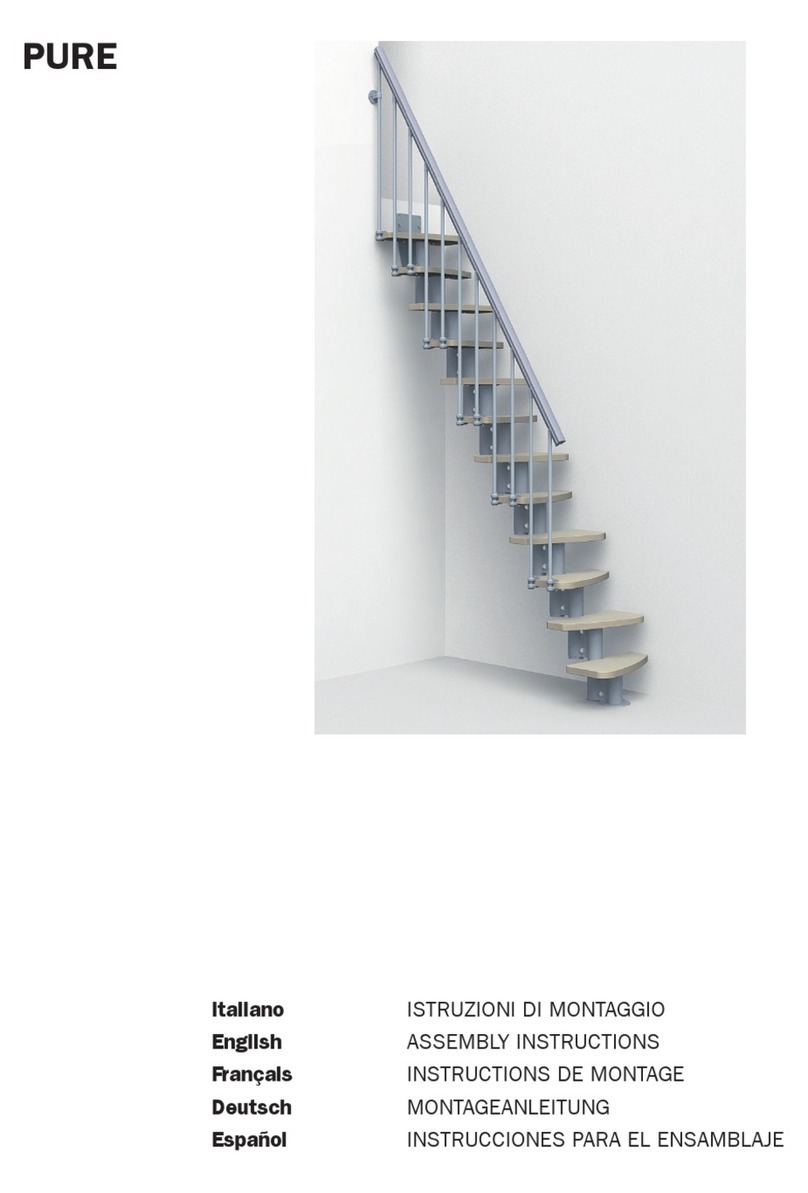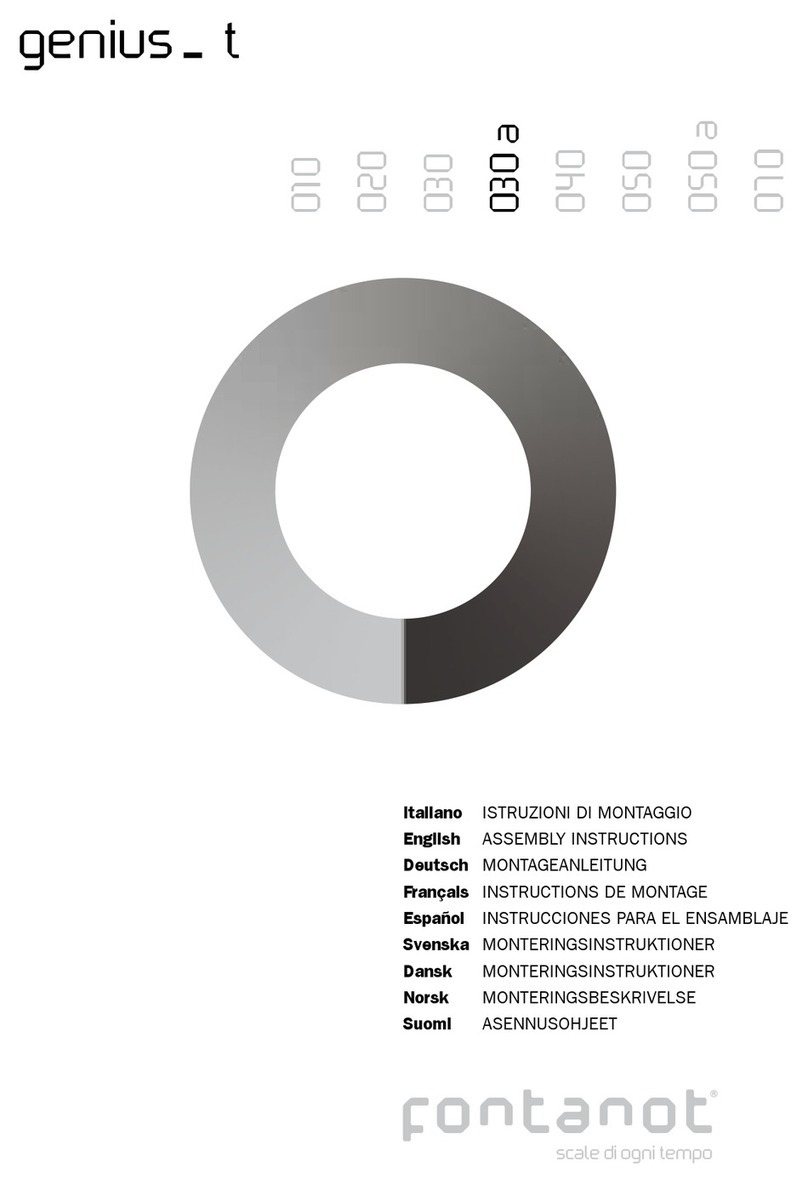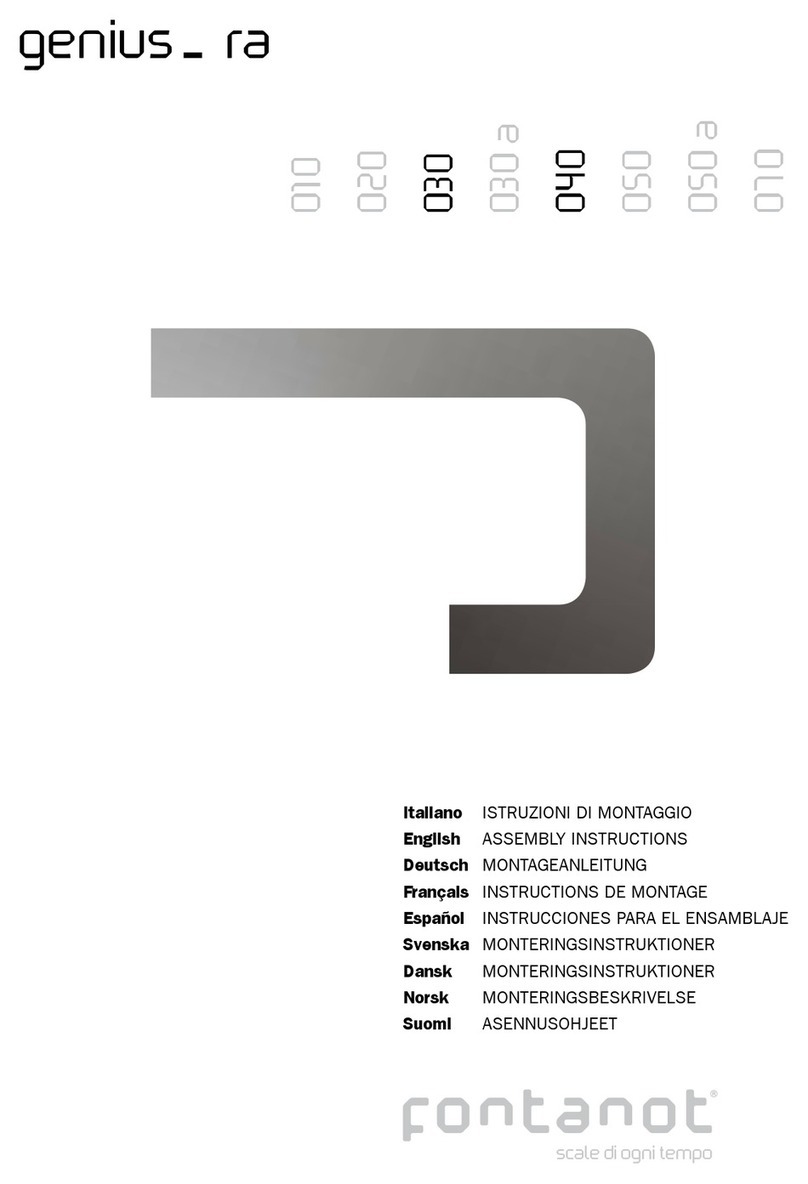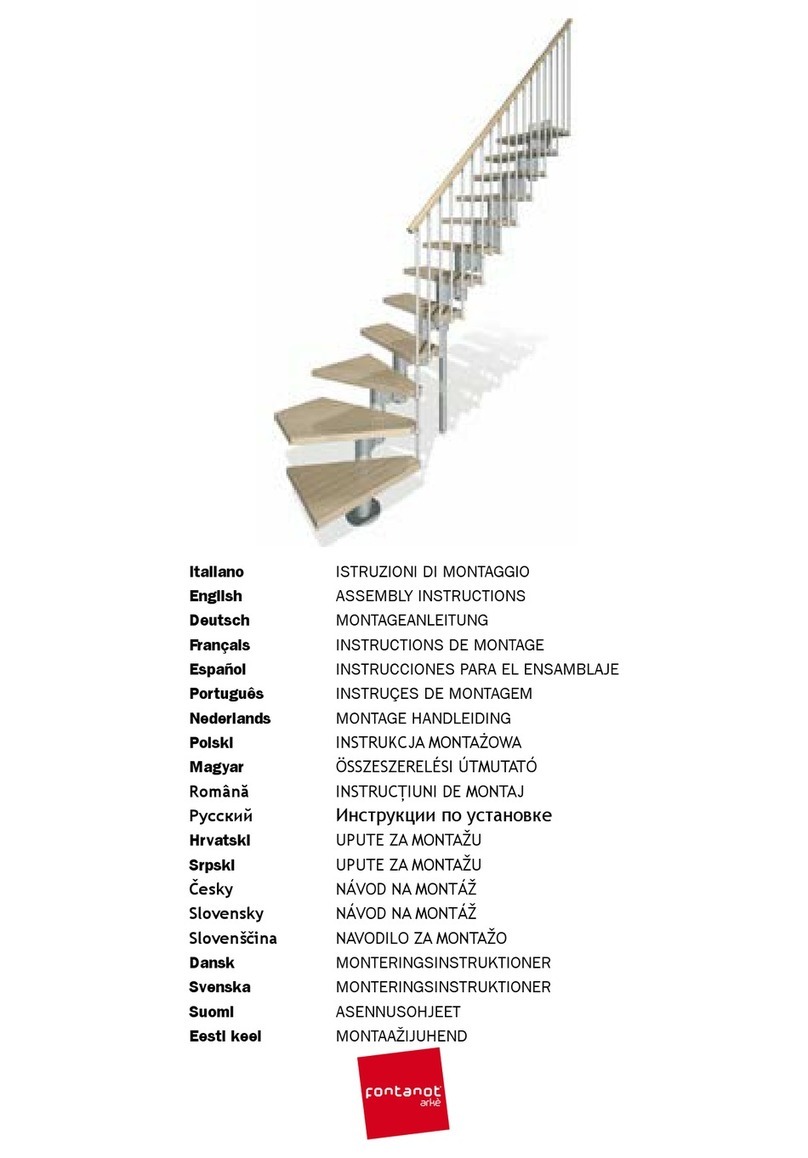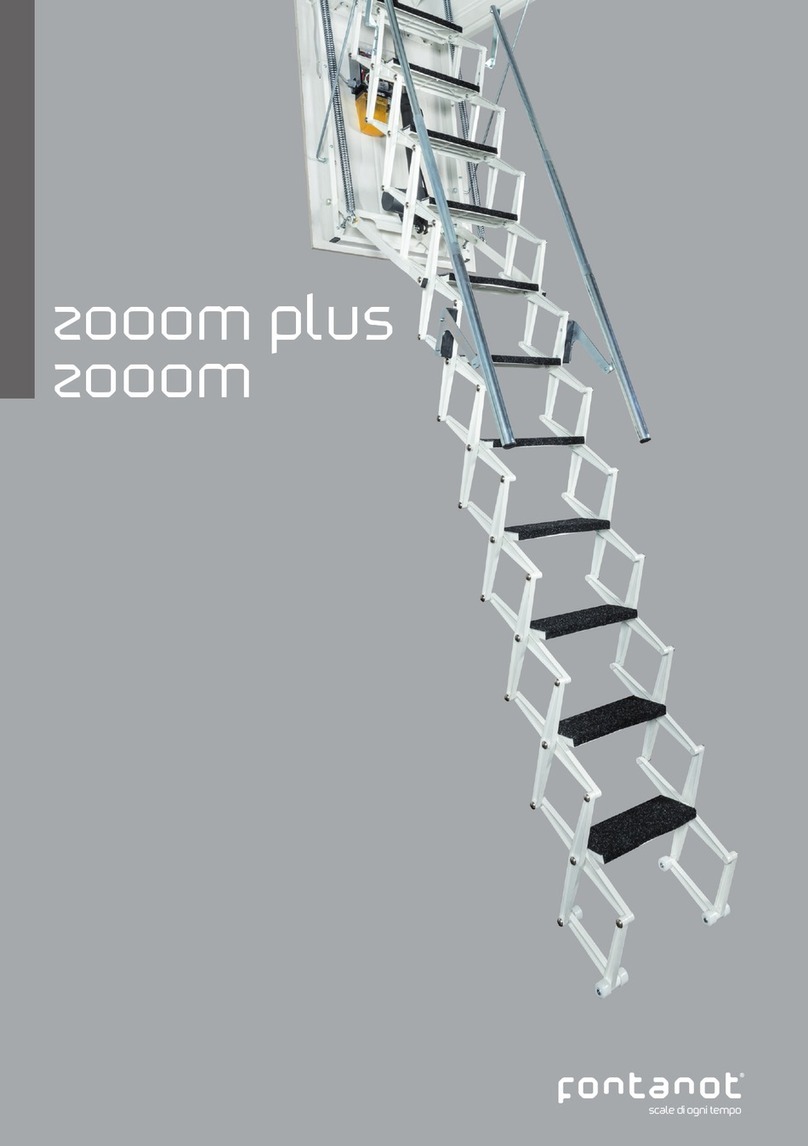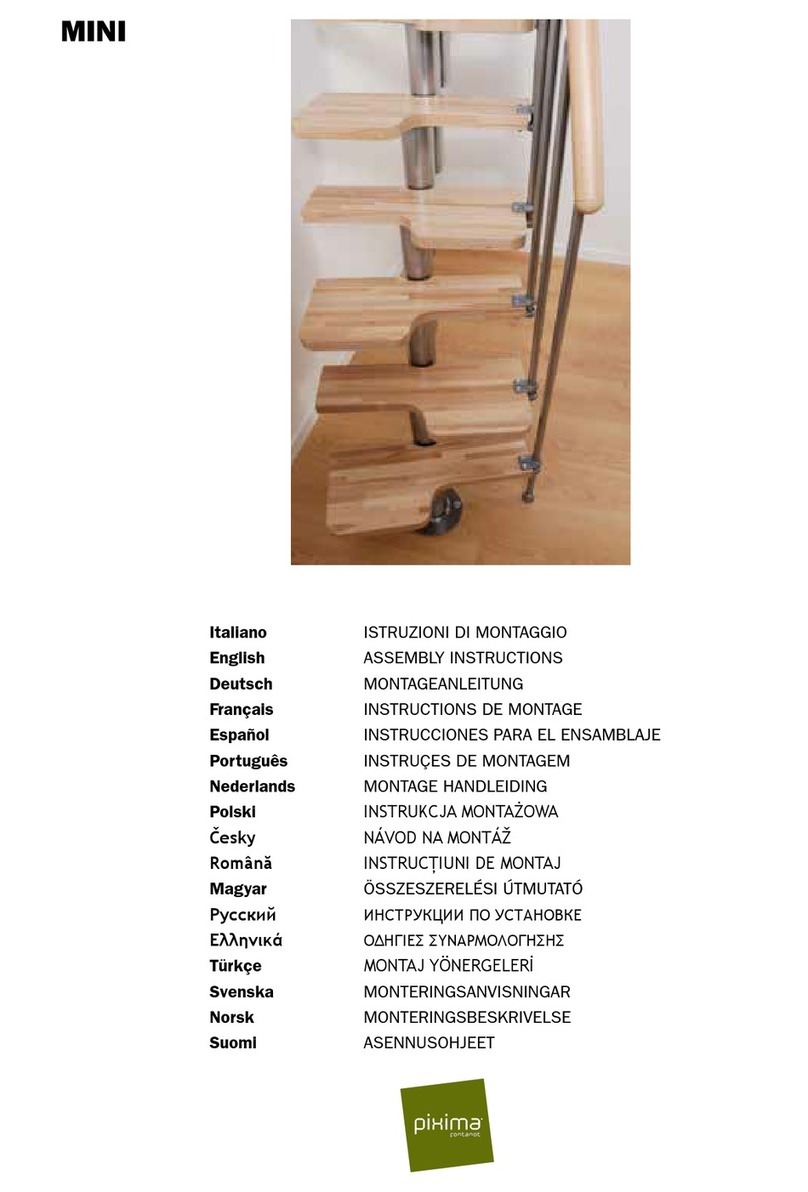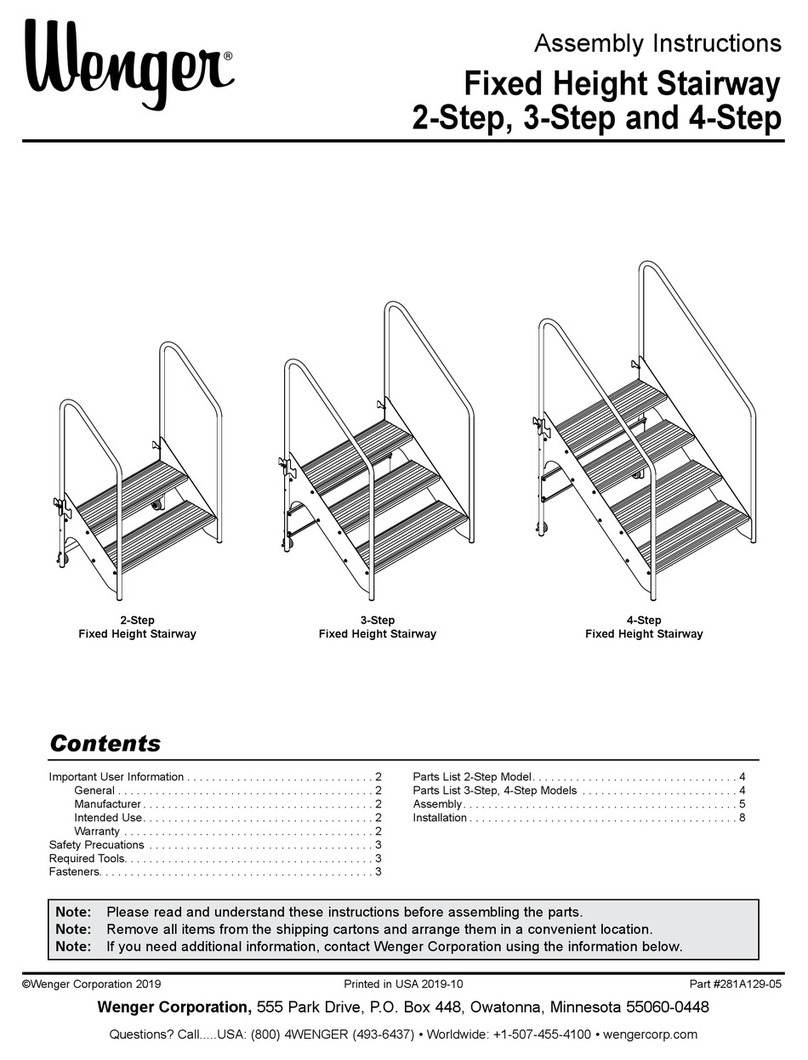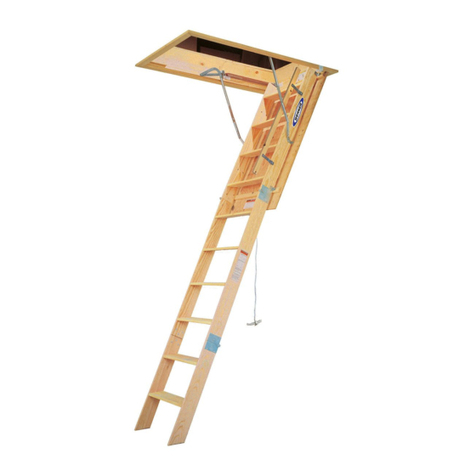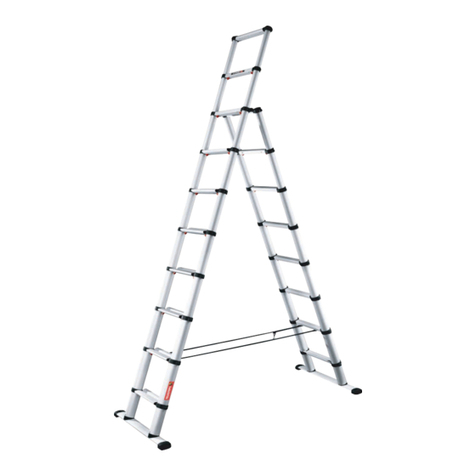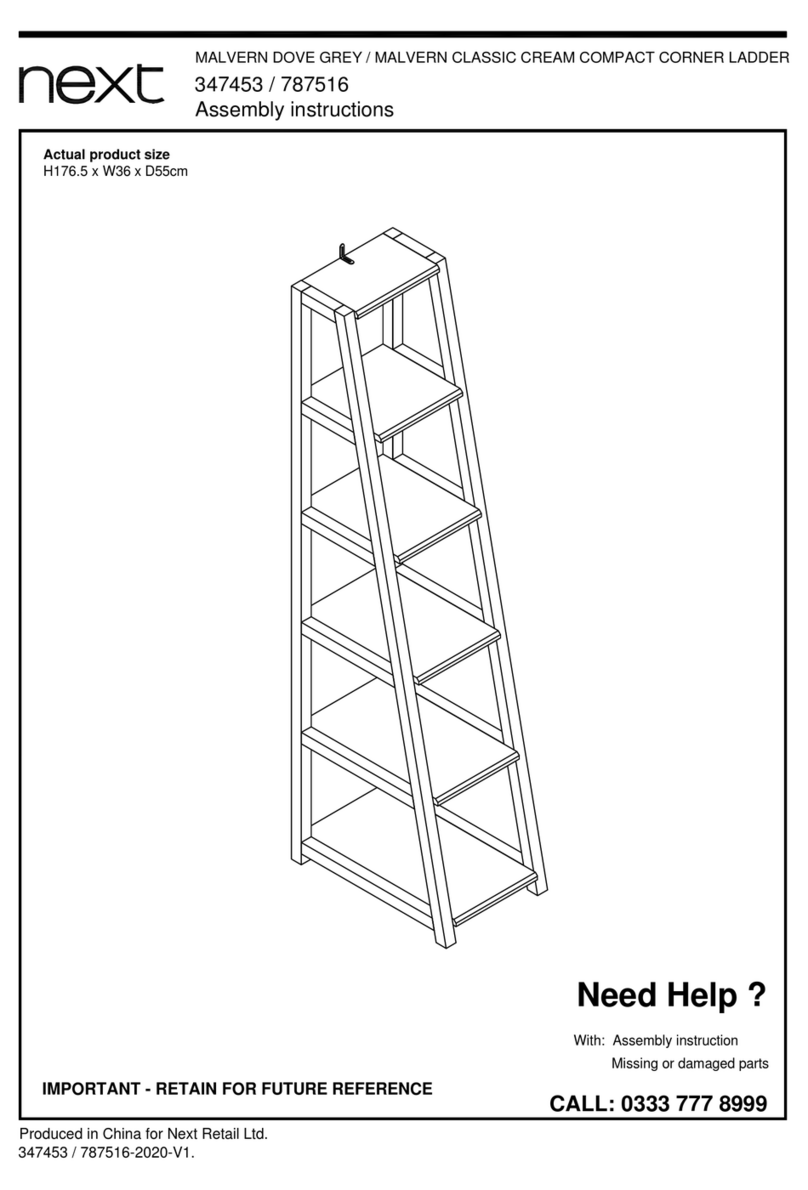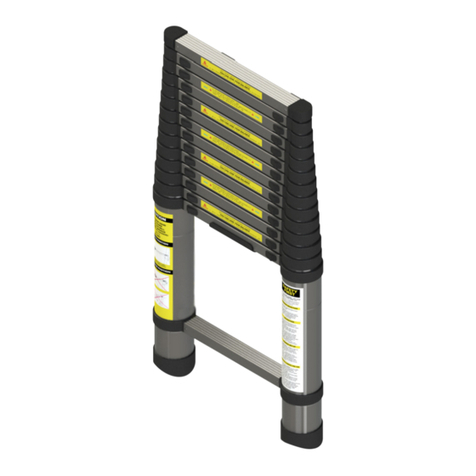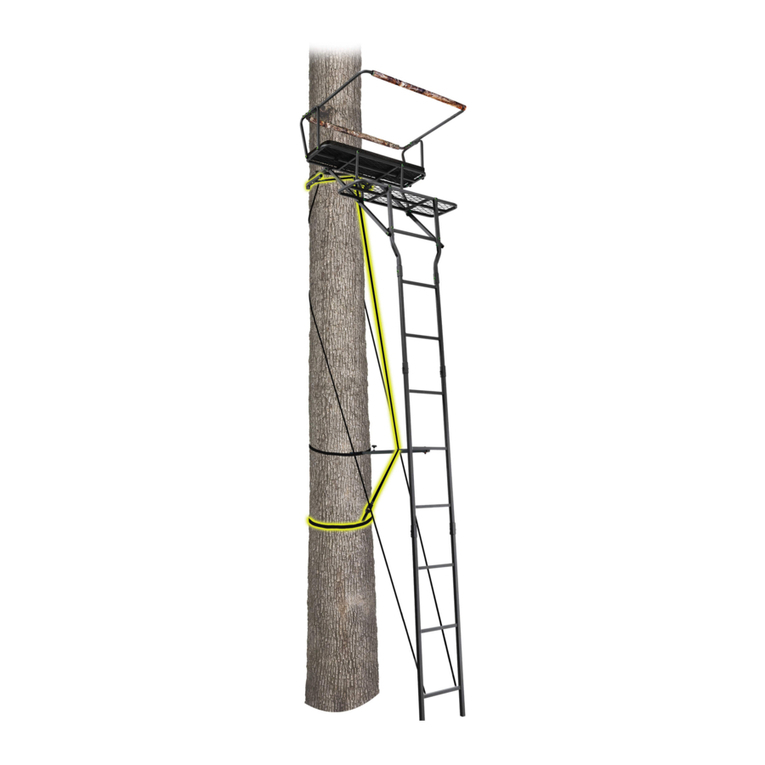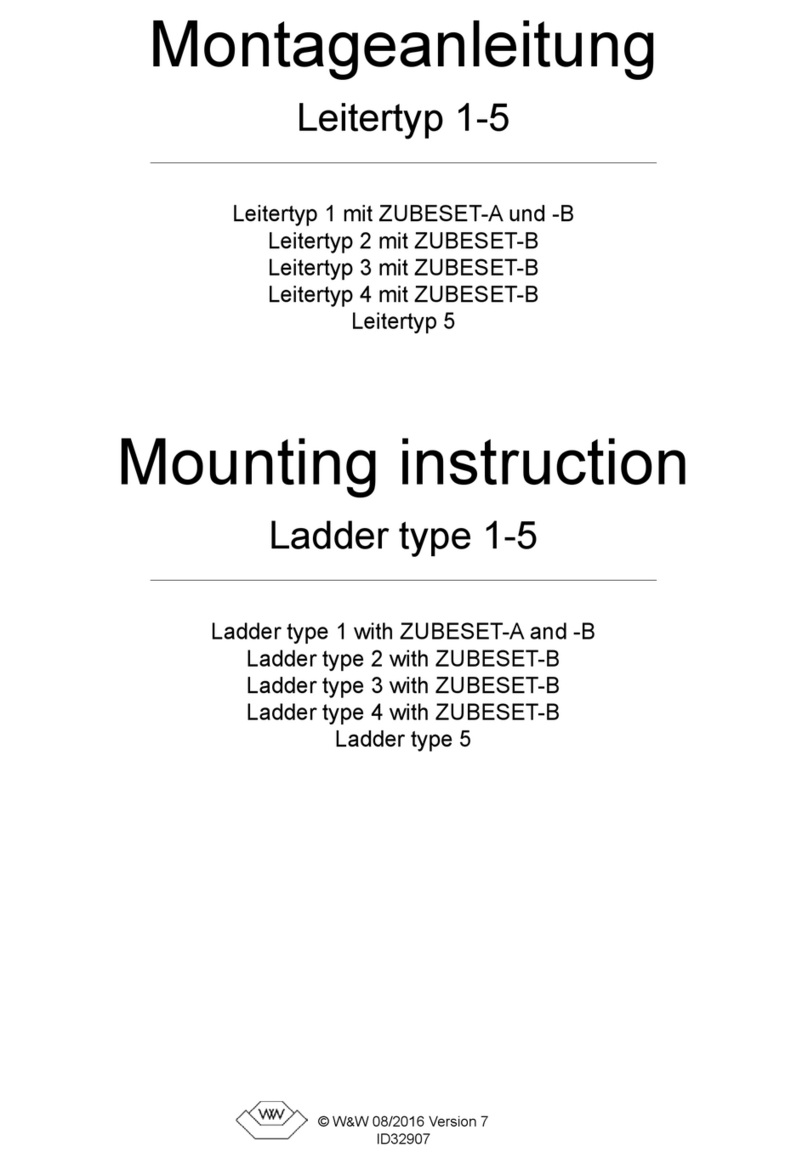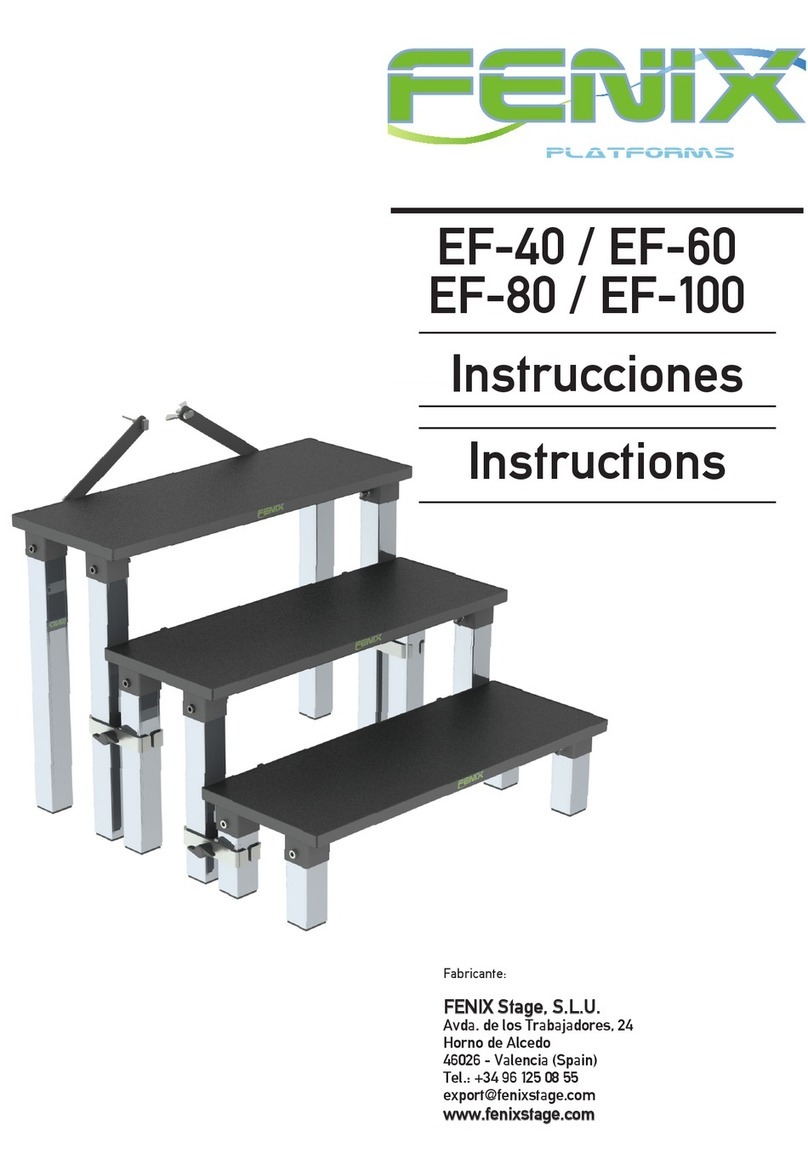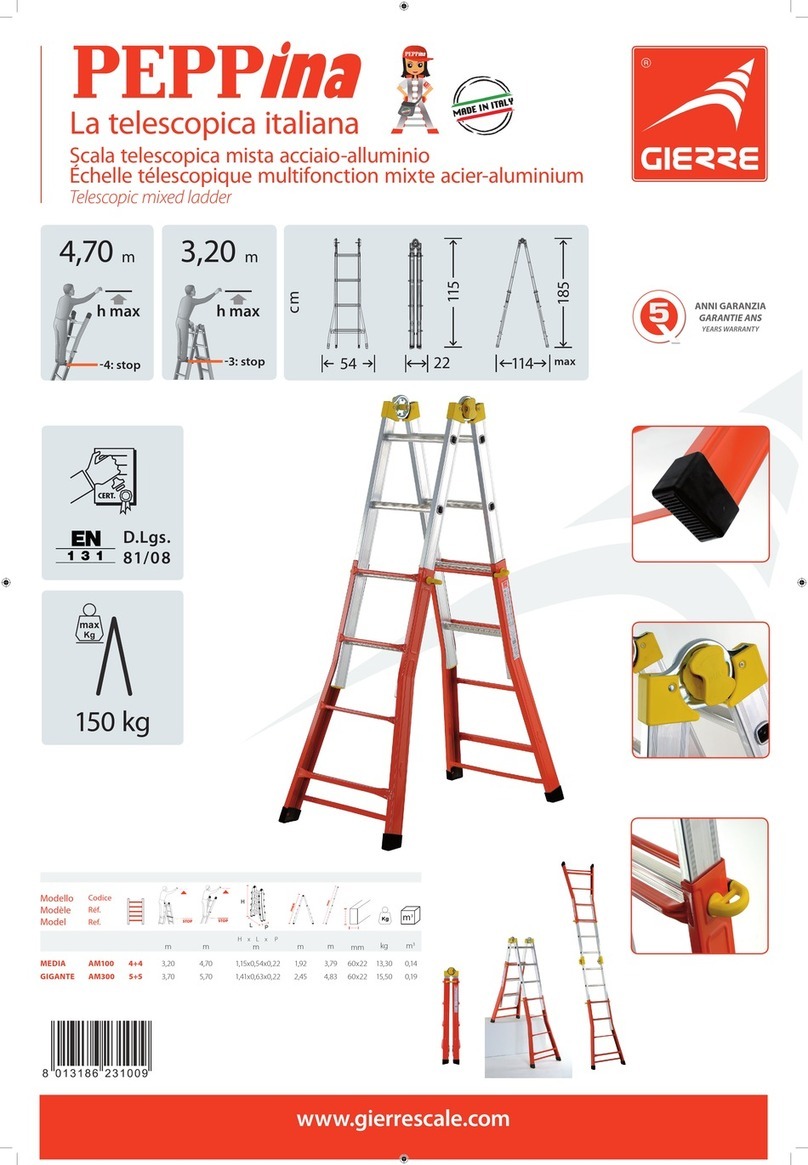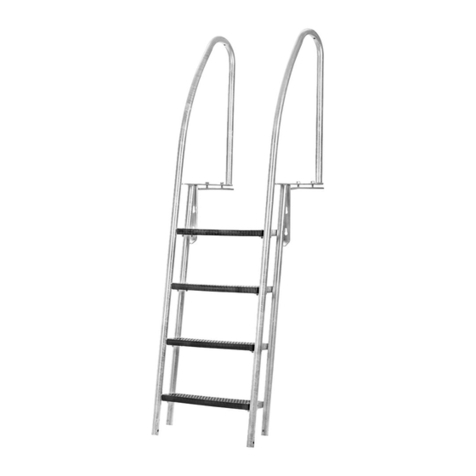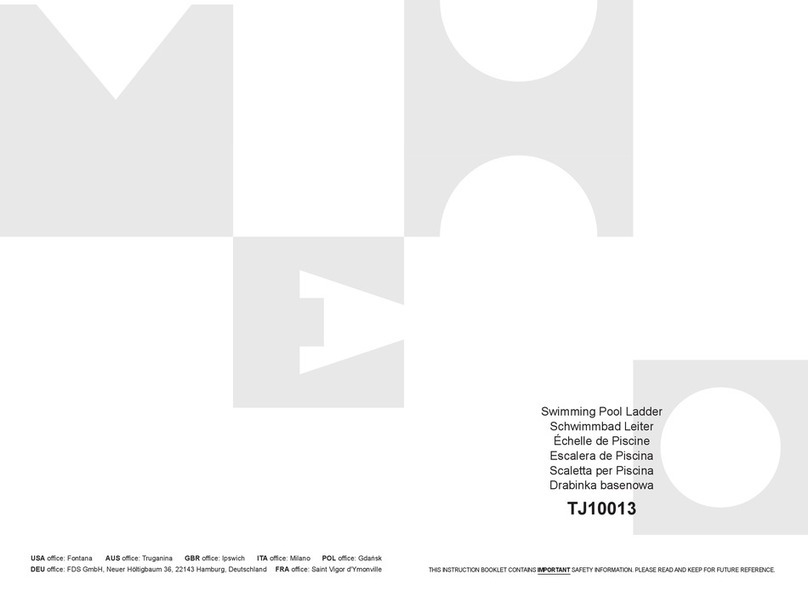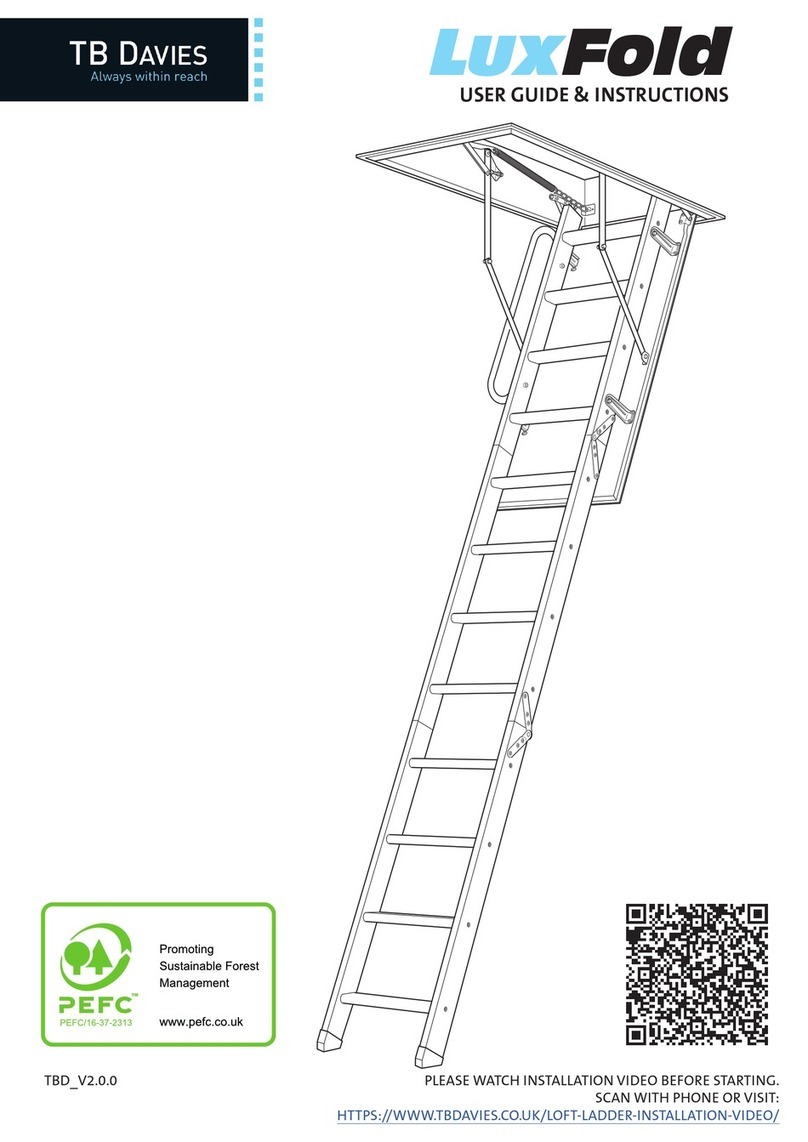Fontanot Zen 2 Tube User manual

Italiano ISTRUZIONI DI MONTAGGIO
English ASSEMBLY INSTRUCTIONS
Deutsch MONTAGEANLEITUNG
Français INSTRUCTIONS DE MONTAGE
Español INSTRUCCIONES PARA EL ENSAMBLAJE
Svenska MONTERINGSANVISNINGAR
Dansk MONTERINGSINSTRUKTIONER
Norsk MONTERINGSBESKRIVELSE
Suomi ASENNUSOHJEET


3 - Z 2 T

4 - Z 2 T
Italiano
ATTENZIONE: eseguire l'installazione "a regola d'arte" utilizzando attrezzi idonei; seguire scrupolosamente
le istruzioni di montaggio. Informarsi prima dell’installazione, sui regolamenti locali e nazionali da
rispettare, in funzione della destinazione d’uso (privato principale, secondario, ufci, negozi...).
Prima di iniziare l’assemblaggio, sballare tutti gli elementi della scala. Sistemarli su una supercie
ampia e vericare la quantità degli elementi (TAB. 1: A = Codice, B = Quantità).
Assemblaggio
1. Misurare attentamente l’altezza da pavimento a pavimento.
2. Calcolare il valore dell’alzata:
1) sottrarre 22 cm al valore trovato dell’altezza da pavimento a pavimento,
2) dividere questo valore per il numero delle alzate meno una.
Esempio: per un’altezza misurata da pavimento a pavimento di 268 cm e una scala con 12
alzate; (268 – 22) / (12 – 1) = 22,36.
3. Determinare la posizione di ssaggio del supporto N19 (g. 1) considerando due punti:
1) l’alzata, precedentemente calcolata, è comprensiva anche dello spessore del gradino L73
(g. 2),
2) posizionare il supporto N19 considerando la tipologia del foro (g. 3).
4. Forare con la punta Ø 14 mm.
5. Assemblare sul pavimento, in congurazione rettilinea, i supporti N19, N18, N17 e N16
considerando l’alzata precedentemente calcolata. Utilizzare gli elementi C15, B71 e B75 (g. 1).
Serrare a sufcienza, considerando che i supporti N19, N18, N17 e N16 devono ancora ruotare
per la congurazione B.
6. Alzare e posizionare la struttura con il supporto N19 a contatto del solaio (g. 4). Nel caso in cui
il vano scala fosse stretto, si consiglia di far ruotare qualche supporto.
7. Fissare denitivamente il supporto N19, utilizzando l’elemento C39 (g. 1).
8. Determinare, a questo punto, il gradino di partenza dall’alto. Forare i gradini L73 utilizzando la
dima di cartone L74 presente nell'imballo alternando un gradino destro con uno sinistro (g.5 ).
9. Decidere dove assemblare la ringhiera (interna od esterna) e forare i gradini L73 con una punta
Ø 6,5 mm, secondo le misure riportate sui disegni di ogni congurazione (g. 3).
10. Assemblare e ssare gli elementi F23 e F29 utilizzando gli elementi C14, B83, C49, C13, B02
(g. 1).
11. Fissare denitivamente i gradini L73 partendo dall’alto no al supporto N16, utilizzando gli
elementi C57 (g. 1).
12. 1. La congurazione A (rettilinea) non necessita di ulteriori modiche (g. 3).
2. La congurazione B necessita di una rotazione di 5° (g. 3).
13. Per ruotare i supporti di 5° procedere come segue:
a. Tracciare con una matita, nel punto di unione di due supporti, due linee verticali ad una
distanza di 3,5 mm (g. 6).
b. Allentare gli elementi C15, un supporto alla volta, partendo dall’alto e ruotare no a far
coincidere una linea con l’altra.
c. Serrare gli elementi C15 denitivamente (g. 1).
Assemblaggio della ringhiera
14. Tagliare le colonnine come riportato nei disegni. Le colonnine poste alle estremità, di cui non
è rilevabile la misura di taglio sui disegni, devono essere tagliate secondo l’inclinazione della
ringhiera della scala e quindi dopo aver montato il corrimano A22.
15. Assemblare gli elementi C63, C65, C66, BG1, C77 e B82 alle colonnine CB6 (g. 7) (g. 1).
(g. 1a); assemblare gli elementi D43, C83, C54, BG1 e C77 alla colonnina CL9 (g. 7) (g. 1).
Attenzione: allineare il foro presente sugli articoli C63 e D43 con i fori presenti sulle colonnine
CB6, CB7 e CL9 (g. 7).
16. Inserire le colonnine CB6 negli elementi F23 , orientando l’elemento C63 con la parte forata
verso l’alto, bloccandole con l’elemento B02. Fissare sul pavimento, in corrispondenza della

5 - Z 2 T
prima colonnina CL9, l’elemento F34, forando con la punta Ø 8 mm. Utilizzare gli elementi B12,
B02, C58. Inserire la colonnina CL9 e stringere l’elemento B02. Curare la verticalità di ogni
colonnina. Cominciando dalla colonnina in alto, ssare il corrimano A22 (lasciare una quantità
di corrimano utile a ssare la colonnina CB6 posta all’estremità e non ancora inserita) con gli
articoli C64 e l’avvitatore. Unire gli elementi di corrimano A22 con gli articoli B33, D72 e la colla
X01. In corrispondenza della prima e dell’ultima colonnina tagliare il corrimano in eccesso con
una sega da ferro e completare il montaggio inserendo l’elemento A37 utilizzando l’articolo C64
e la colla X01 (g. 1).
17. Determinare la lunghezza dei tondini A39 in base alle caratteristiche dimensionali della scala e
tagliarli. Inserire i tondini A39 negli articoli BG1 assemblati in precedenza sulle colonnine CB6
(g. 1-1a). Assemblare sulla colonnina di partenza CL9 gli articoli D40 e C76 e far scorrere
il tondino A39 al loro interno, facendolo uscire di 15 mm dal bordo dell’articolo BG1. Inserire
all’estremità del tondino l’elemento D38 e serrarlo con l’elemento C76 (g. 1-1a). Fissare il
tondino serrando l’elemento C76 posto sull’articolo D40. Continuare ad assemblare il resto dei
tondini A39 unendoli tra loro utilizzando l'articolo A41 e la colla in dotazione (g. 1a).
Assemblaggio nale
18. Vericare la verticalità di tutta la scala e, se necessario, correggerla spostando il supporto N16
(g. 1).
19. Smontare il primo gradino L73 e forare il pavimento con la punta Ø 14 mm in corrispondenza dei
fori presenti nel supporto N16 (g. 1).
20. Inserire gli elementi C39 e stringere denitivamente (g. 1).
21. Rimontare il primo gradino L73.
22. Per irrigidire ulteriormente la scala, ssare a muro gli elementi F09 e unirli, utilizzando gli
elementi F08, con le colonnine CB6. Forare con una punta Ø 8 mm e utilizzare gli elementi C50,
C49, C58, B12 (g. 1a).

6 - Z 2 T
English
WARNING: Carry out the installation in a “workmanlike” manner, strictly following the installation
instructions and using suitable tools. Always consult your local building department for code requirements
that must be respected depending on its destination of use (private, secondary, public…).
Unpack each element before starting to assemble the staircase. Position the elements on an ample
surface and check their quality (TAB. 1: A = Code, B = Quality).
Assembly
1. Carefully measure the height from oor to oor.
2. Calculate the rise:
1) subtract 22 cm from the height measured from oor to oor,
2) divide by the number of rises minus one.
Example: for a height from oor to oor of 268 cm and a staircase with 12 rises;
(268 – 22) / (12 – 1) = 22.36.
3. Determine the position to x support N19 (g. 1) considering two points:
1) that the rise, previously calculated, also includes the thickness of the L73 tread (g. 2).
2) position support N19 taking into account the type of opening (g. 3).
4. Drill with a Ø 14 mm point.
5. Assemble supports N19, N18, N17 and N16 in a straight conguration on the oor, taking the rise
calculated before into account. Use elements C15, B71 and B75 (g. 1). Secure in an adequate
manner, considering that supports N19, N18, N17 and N16 must still rotate for conguration B.
6. Raise and position the structure keeping support N19 in contact with the oor (g. 4). If the bay
of the stairs is narrow, we recommend rotating a few supports.
7. Secure support N19 in a permanent manner, using element C39 (g. 1).
8. Determine at this point which is the rst step from the top. Drill L73 treads using the L74
cardboard cutout jig you nd in the package, alternating a right tread and a left tread (g. 3).
9. Decide where the railing will be assembled (internal or external) and drill the L73 treads using a Ø
6.5 mm bit, according to the measurements found on the drawings for each conguration (g. 3).
10. Assemble and secure elements F23 and F29 using elements C14, B83, C49, C13, B02 (g. 1).
11. Secure the L73 treads in a permanent manner starting from the top until you reach support N16,
using elements C57 (g. 1).
12. 1. Conguration A (straight) does not require further modications (g. 3).
2. Conguration B requires a 5 ° rotation (g. 3).
13. To rotate the supports by 5°, proceed as follows:
a. Using a pencil in the point of connection between the supports, trace two vertical lines at a
distance of 3.5 mm (g. 5).
b. Loosen elements C15, one support at the time, starting from the top and rotate until one line
coincides with the other.
c. Secure elements C15 in a permanent manner (g. 1).
Railing assembly
14. Cut the balusters as described in the diagrams. The balusters at the ends, where the cut
measurement on the drawings cannot be seen, must be cut based on the slope of the railing for
the staircase, in other words after handrail A13 has been mounted.
15. Assemble parts C63, C65, C66, BG1, C77 and B82on the balusters CB6 (Fig. 6, Fig. 1, Fig. 1a);
assemble parts D43, C83, C54, BG1 and C77 on the CL9 baluster (Fig. 6, Fig.1). Caution: align the
holes in parts C63 and D43 with the holes in the CB6, CB7 and CL9 balusters (Fig. 6)
16. Insert the CB6 balusters into F23 elements, positioning C63 element with the open part towards
the top, locking them with element B02. Secure element F34 to the oor, next to the rst baluster
CL9 and drill using a Ø 8 mm bit. Use elements B12, B02, C58. Insert the CL9 baluster and
tighten element B02. Check the verticality of each baluster. Starting from the baluster at the top,
secure the A22 handrail (leave the amount of handrail required to secure baluster CB6, which
goes at the end and has not been inserted yet) using articles C64 and an electric screwdriver.

7 - Z 2 T
Join the handrail A22 elements to articles B33 and D72 using the X01 glue. Saw off the excess
handrail next to the rst and last baluster using a hacksaw and complete assembly by inserting
element A37 using article C64 and X01 glue (g. 1).
17. Determine the length of the A39 bars based on the dimensions of the staircase and cut them.
Insert the A39 bars into parts BG1 previously assembled on the CB6 balusters (Fig. 1-1a).
Assemble parts D40 and C76 on the CL9 starting baluster and slide the A39 bar inside them
letting it protrude 15mm from the edge of part BG1. Fit part D38 at the end of the bar and tighten
it with part C76 (Fig. 1). Secure the bar by tightening part C76 placed on part D40. Continue
with assembly of the rest of the A39 bars joining them to each other using part A41 and the glue
provided (Fig. 1a).
Final Assembly
18. Check the verticality of the entire staircase and - if necessary - correct by moving support N16
(g. 1).
19. Dismantle the rst L73 tread and drill the oor using a Ø 14 mm point in the same place as the
openings found on support N16 (g. 1).
20. Insert elements C39 and secure in a permanent manner (g. 1).
21. Remount the rst L73 tread.
22. To further stiffen the staircase, fasten parts F09 to the wall and join them to the CB6 balusters
using parts F08. Drill using an 8mm Ø bit and use parts C50, C49, C58, B12 (Fig. 1a).

8 - Z 2 T
Deutsch
ACHTUNG: Die Montage muss fachgerecht, unter Zuhilfenahme geeigneter Hilfsmittel und unter strikter
Einhaltung der Montageanleitung ausgeführt werden. Damit die Montage normgerecht erfolgen kann,
muss man zuvor Informationen zur Aufstellung und zu den lokal und national geltenden Vorschriften je
nach Bestimmungszweck (privat, Haupt- oder Nebeneinrichtung, Büros, Geschäfte, …) einholen.
Vor dem Zusammenbau alle Treppenteile aus der Verpackung nehmen. Die Teile auf einer großen
Fläche auegen und ihre Anzahl überprüfen (TAB. 1: A = Code, B = Anzahl).
Montage
1. Die Geschosshöhe exakt messen.
2. Das Maß der Steigung berechnen:
1) 22 cm von der gemessenen Geschosshöhe abziehen,
2) diesen Wert durch die Anzahl der Steigungen minus einer dividieren.
Beispiel: bei einer gemessenen Geschosshöhe von 268 cm und einer Treppe mit 12 Steigungen;
(268 - 22) : (12 - 1) = 22,36
3. Die Position für die Befestigung der Stütze N19 (Abb. 1) unter Berücksichtigung zweier Faktoren
bestimmen:
1) die zuvor berechnete Steigung versteht sich einschließlich der Stufenstärke L73 (Abb. 2).
2) die Stütze N19 ist unter Berücksichtig der Art des Bohrlochs anzulegen (Abb. 3).
4. Das Bohrloch mit einem Bohrer Ø 14 mm ausführen.
5. Die Stützen N19, N18, N17 und N16 unter Berücksichtigung der zuvor berechneten Steigung
in gerader Konguration auf dem Fußboden zusammenbauen. Die Teile C15, B71 und B75
verwenden (Abb. 1). Die Teile ausreichend festziehen und dabei beachten, dass sich die Stützen
N19, N18, N17 und N16 für die Positionierung in Konguration B noch drehen müssen.
6. Die Konstruktion anheben und so positionieren, dass die Stütze N19 die Decke berührt (Abb. 4).
Sollte das Treppenhaus eng sein, wird empfohlen, einige der Stützen zu drehen.
7. Die Stütze N19 mit dem Teil C39 endgültig befestigen (Abb. 1).
8. An dieser Stelle die erste Stufe von oben ab bestimmen. Die Stufen L73 mit Hilfe der in der
Verpackung enthaltenen Pappschablone L74, bei Wechsel einer rechten mit einer linken Stufe
(Abb. 3), bohren.
9. Bestimmen, wo das Geländer montiert werden soll (innen oder außen) und die Stufen L73 mit
einem Bohrer Ø 6,5 mm gemäß den auf den Zeichnungen jeder Konguration angegebenen
Maßen anbohren (Abb. 3).
10. Die Teile F23 und F29 mit Hilfe der Elemente C14, B83, C49, C13 und B02 zusammenbauen und
befestigen (Abb. 1).
11. Die Stufen L73 oben beginnend, bis zur Stütze N16 mit den Teilen C57 endgültig befestigen (Abb.
1).
12. 1. Die Konguration A (gerade) bedarf keiner weiteren Änderungen (Abb. 3).
2. Bei der Konguration B ist eine Drehung um 5° notwendig (Abb. 3).
13. Beim Drehen der Stützen um 5° wie folgt vorgehen:
a. An der Verbindungsstelle zweier Stützen mit einem Bleistift zwei vertikale Linien in einem
Abstand von 3,5 mm zueinander ziehen (Abb. 5).
b. Bei jeweils einer Stütze die Teile C15 oben beginnend lockern und die Stütze drehen, bis eine
Linie mit der anderen übereinstimmt.
c. Die Teile C15 endgültig festziehen (Abb. 1).
Zusammenbau des Geländers
14. Die Geländerstäbe wie in den Zeichnungen dargestellt, zuschneiden. Der Zuschnitt des ersten
und letzten Geländerstabs, deren Maß nicht aus den Zeichnungen ersichtlich ist, hängt von der
Neigung des Treppengeländers ab und erfolgt daher erst nach der Montage des Handlaufs A22.
15. Die Elemente C63, C65, C66, BG1, C77 und B82 auf den Geländerstäben CB6 befestigen (Abb. 6,
Abb. 1, Abb. 1a); die Elemente D43, C83, C54, BG1 und C77 auf dem Geländerstab CL9 befestigen
(Abb. 6, Abb. 1).
Achtung: Das Bohrloch auf den Artikeln C63 und D43 mit den Löchern auf den Geländerstäben CB6,

9 - Z 2 T
CB7 und CL9 ausrichten (Abb. 6).
16. Die Geländerstäbe CB6 in die Elemente F23 einsetzen, das Element C63 mit der angebohrten
Seite nach oben ausrichten und die Stäbe mit dem Element B02 befestigen. Das Element F34
in Übereinstimmung mit dem ersten Geländerstab CL9 auf dem Fußboden befestigen (nur,
wenn das Geländer von unten gesehen links montiert ist). Das Bohrloch mit einem Bohrer
Ø 8 mm ausführen. Die Elemente B12, B02 und C58 verwenden. Den Geländerstab CL9
einsetzen und das Element B02 festziehen. Darauf achten, dass alle Geländerstäbe senkrecht
stehen. Den Handlauf A22 beim obersten Geländerstab beginnend, mit den Teilen CB6 und
dem Elektroschrauber befestigen (ein Stück Handlauf für den letzten Geländerstab C67
berücksichtigen, der noch nicht eingesetzt ist). Die Elemente des Handlaufs A22 mit den Teilen
B33, D72 und dem Klebstoff X01 verbinden. Den überüssigen Handlauf in Übereinstimmung mit
dem ersten und letzten Geländerstab mit einer Eisensäge abschneiden. Das Element A37 mit
dem Teil C64 und dem Klebstoff X01 einsetzen, um die Montage zu vervollständigen (Abb. 1).
17. Die Länge der Rundstäbe A30 je nach Größe der Treppe bestimmen und die Stäbe zuschneiden.
Die Rundstäbe A39 in die Artikel BG1 einsetzen, die zuvor auf den Geländerstäben CB6 montiert
wurden (Abb. 1-1a). Auf dem Anfangsgeländerstab CL9 die Artikel D40 und C76 montieren und
den Rundstab A39 in die Artikel einführen und 15 mm aus Artikel BG1 herausragen lassen. Das
Element D38 am Ende des Rundstabs einsetzen und mit dem Element C76 festziehen (Abb.
1-1a). Den Rundstab befestigen und dazu das Element C76 auf dem Artikel D40 festziehen.
Die weiteren Rundstäbe A39 montieren und untereinander mit dem Artikel A41 und dem
mitgelieferten Klebstoff verbinden (Abb. 1a).
Abschließende Arbeit
18. Kontrollieren, ob die gesamte Treppe gerade steht und für evtl. Korrekturen die Stütze N16
verschieben (Abb. 1).
19. Die erste Stufe L73 entfernen und den Fußboden in Übereinstimmung mit den Löchern in der
Stütze N16 mit einem Bohrer Ø 14 mm anbohren (Abb. 1).
20. Die Elemente C39 einsetzen und endgültig festziehen (Abb. 1).
21. Die erste Stufe L73 wieder montieren.
22. Um die Treppe zu stabilisieren, werden die Elemente F09 an der Wand befestigt und unter
Verwendung der Elemente F08 mit den Geländerstäben CB6 verbunden. Mit einem Bohrer Ø 8 mm
ein Bohrloch ausführen und die Elemente C50, C49, C58, B12 verwenden (Abb. 1a).

10 - Z 2 T
Français
ATTENTION : Effectuer l’installation dans les règles de l’art en utilisant des outils appropriés ; suivre
scrupuleusement les instructions de montage. Pour réaliser un montage conforme aux normes en
vigueur, il faut s’informer avant l’installation quant aux réglementations locales et nationales à respecter,
en fonction du domaine d’utilisation (résidence privée principale, secondaire, bureaux, magasins,…).
Avant de procéder à l’assemblage, déballer toutes les pièces de l’escalier. Les placer sur une surface
sufsamment grande et vérier la quantité d’éléments (TAB. 1: A = Code, B = Quantité).
Assemblage
1. Mesurer soigneusement la hauteur de plancher à plancher.
2. Calculer la valeur de la hauteur de la contremarche:
1) soustraire 22 cm à la valeur obtenue pour la hauteur de plancher à plancher,
2) diviser cette valeur par le nombre de contremarches moins une.
Exemple: pour une hauteur de plancher à plancher de 268 cm et un escalier avec 12
contremarches;
(268 – 22) / (12 – 1) = 22,36
3. Dénir la position de xation du support N19 (g. 1) en tenant compte de deux points:
1) la hauteur de la contremarche, calculée précédemment, comprend aussi l’épaisseur de la
marche L73 (g. 2).
2) positionner le support N19 en tenant compte du type de trou (g. 3).
4. Percer avec une mèche Ø 14 mm.
5. Assembler sur le sol, dans une conguration rectiligne, les supports N19, N18, N17 et N16 en
tenant compte de la hauteur de la contremarche calculée précédemment. Utiliser les pièces C15,
B71 et B75 (g. 1). Serrer sufsamment en considérant que les supports N19, N18, N17 et N16
doivent encore tourner dans la conguration B.
6. Lever et positionner la structure, le support N19 étant en contact avec le plafond (g. 4). Si la
cage d’escalier est étroite, nous vous conseillons de faire tourner quelques supports.
7. Fixer le support N19 de manière dénitive, en utilisant la pièce C39 (g. 1).
8. A ce moment, établir quelle est la marche de départ en partant du haut. Percer les marches L73,
en utilisant le patron en carton L74 présent dans l’emballage, avec soin de l’alternance d’une
marche droite avec une gauche (g. 3).
9. Choisir où sera assemblée le garde-corps (externe ou interne) et percer les marches L73 avec
une mèche Ø 6,5 mm, selon les dimensions indiquées sur les dessins de chaque conguration
(g. 3).
10. Assembler et xer les pièces F23 et F29 en utilisant les pièces C14, B83, B86, C13, B02 (g. 1).
11. Fixer les marches L73 de manière dénitive en partant du haut jusqu’au support N16, en utilisant
les pièces C57 (g. 1).
12. 1. Pour la conguration A (rectiligne), aucune autre modication n’est nécessaire (g. 3).
2. Pour la conguration B, une rotation de 5° est nécessaire (g. 3).
13. Pour effectuer une rotation de 5°, il faut:
a. Tracer avec un crayon, au point de jonction des deux supports, deux lignes verticales à une
distance de 3,5 mm (g. 5).
b. Desserrer les pièces C15, un support à la fois, en partant du haut et tourner jusqu’à ce qu’une
ligne coïncide avec l’autre.
c. Serrer les pièces C15 de manière dénitive (g. 1).
Assemblage du garde-corps
14. Couper les colonnettes comme dans les dessins. Les colonnettes situées aux extrémités dont
on ne peut pas relever la dimension de la coupe sur les dessins, doivent être coupées suivant
l’inclinaison du garde-corps de l’escalier et, par conséquent, après avoir monté la main-courante
A22.
15. Assembler les éléments C63, C65, C66, BG1 et C82 et les colonnettes CB6 (g. 6, g. 1a) ;
assembler les éléments D43, C83, C54, BG1 et C77 et la colonnette CL9 (g. 1 et 6).
Attention : aligner le trou présent sur les pièces C63 et D43 avec les trous présents sur les

11 - Z 2 T
colonnettes CB6, CB7 et CL9 (g. 6).
16. Introduire les colonnettes CB6 dans les pièces F23, en orientant la pièce C63 avec la partie
percée tournée vers le haut en les bloquant avec la pièce B02. Fixer sur le sol la pièce F34, en
correspondance de la première colonnette CL9, en perçant avec une mèche Ø 8 mm. Utiliser
les pièces B12, B02 et C58. Introduire la colonnette CL9 et serrer la pièce B02. Veiller à ce que
chaque colonnette soit bien verticale.
En commençant par la colonnette du haut, xer la main-courante A22 (laisser une quantité de
main-courante permettant de xer la colonnette CB6 située à l’extrémité et non encore insérée)
avec les articles C64 et la visseuse. Monter les pièces de la main-courante A22 sur les articles
B33 et D72 avec la colle X01. En correspondance de la première et de la dernière colonnette,
couper la partie de la main-courante en excédent avec une scie à métaux et terminer le montage
en introduisant la pièce A37 en utilisant l’article C64 et la colle X01 (g. 1).
17. Déterminer la longueur des tiges A39 selon les caractéristiques dimensionnelles de l'escalier
et les couper. Insérer les tiges A39 dans les pièces BG1 précédemment assemblées, sur les
colonnettes CB6 (g. 1 et 1a). Assembler les pièces D40 et C76 sur la colonnette de départ
CL9 et passer la tige A39 à l'intérieur, en la faisant dépasser de 15 mm de la pièce BG1. Insérer
l'élément D38 à l'extrémité de la tige, et serrer à l'aide de la pièce C76 (g. 1-1a). Fixer la tige en
serrant l'élément C76 installé sur la pièce D40. Continuer à assembler les autres tiges A39 en
les reliant à l'aide de la pièce A41 et de la colle fournie (g. 1a). .
Assemblage nal
18. Vérier la verticalité de tout l’escalier et, si nécessaire, la corriger en déplaçant le support N16
(g. 1).
19. Démonter la première marche L73 et percer le sol avec une mèche Ø 14 mm en correspondance
des trous situés sur le support N16 (g. 1).
20. Introduire les pièces C39 et serrer de manière dénitive (g. 1).
21. Remonter la première marche L73.
22.An de rendre plus rigide l’escalier, xer au mur les éléments F09 et les unir, en employant les
éléments F08, avec les colonnettes CB6. Percer avec une mèche Ø 8 mm et utiliser les pièces
C50, C49, C58 et B12 (g. 1a)

12 - Z 2 T
Español
CUIDADO: realizar la instalación "según las reglas del arte", utilizando herramientas adecuadas; seguir
estrictamente las instrucciones de montaje. Informarse antes de la instalación sobre los reglamentos
locales y nacionales a respetar, en función del destino de uso (privado principal, secundario, ocinas,
tiendas…).
Antes de empezar a montar, desembalar todos los elementos de la escalera. Colocarlos en una
supercie amplia y comprobar el número de elementos (TAB. 1: A = Código, B = Cantidad).
Montaje
1. Medir con cuidado la altura de suelo a suelo.
2. Calcular el valor de la contrahuella:
1) restar 22 cm al valor de la altura de suelo a suelo,
2) dividir este valor por el número de contrahuellas, menos una.
Ejemplo: para una altura de suelo a suelo de 268 cm y una escalera de 12 contrahuellas;
(268 – 22) / (12 – 1) = 22,36.
3. Determinar la posición de jación del soporte N19 (g. 1) considerando dos cosas:
1) la contrahuella, calculada precedentemente, incluye el espesor del peldaño L73 (g. 2).
2) colocar el soporte N19 considerando el tipo de agujero (g. 3).
4. Taladrar con la broca Ø 14 mm.
5. Montar en el suelo, con conguración rectilínea, los soportes N19, N18, N17 y N16 considerando
la contrahuella calculada precedentemente. Utilizar los elementos C15, B71 y B75 (g. 1).
Apretar lo suciente, considerando que los soportes N19, N18, N17 y N16 de la conguración B
todavía deben girar.
6. Levantar y colocar la estructura con el soporte N19 en contacto con el entramado (g. 4).
En el caso de que el hueco de la escalera fuera estrecho, se aconseja girar algunos soportes
7. Fijar denitivamente el soporte N19, utilizando el elemento C39 (g. 1).
8. Determinar el escalón de salida desde arriba. Taladrar los peldaños L73 utilizando la plantilla L74
de cartón incluida en el embalaje, alternando un peldaño derecho con uno izquierdo (g. 3).
9. Decidir dónde montar la barandilla (interna o externa) y taladrar los peldaños L73 con una broca Ø
6,5 mm, según las medidas de los dibujos de cada conguración (g. 3).
10. Montar y jar los elementos F23 y F29 utilizando los elementos C14, B83, B86, C13, B02 (g. 1).
11. Fijar denitivamente los peldaños L73 partiendo desde arriba hasta el soporte N16, utilizando los
elementos C57 (g. 1).
12. 1. La conguración A (rectilínea) no necesita más modicaciones (g. 3).
2. La conguración B necesita una rotación de 5° (g. 3).
13. Para girar los soportes de 5° hay que:
a. Trazar con un lápiz, en el punto de unión de dos soportes, dos líneas verticales a una distancia
de 3,5 mm (g. 5).
b. Aojar los elementos C15, un soporte a la vez, partiendo desde arriba y girar hasta que
coincida una línea con otra.
c. Apretar los elementos C15 denitivamente (g. 1).
Ensamblaje de la barandilla
14. Cortar los barrotes como indican los dibujos. Los barrotes situados en los extermos, para los que
los dibujos no indican medidas, se tienen que cortar según la inclinación de la barandilla de la
escalera, y por lo tanto, después de haber montado el pasamanos A22.
15. Ensamble los elementos C63, C65, C66, BG1, C77 y B82 a los barrotes CB6 y CB7 (g. 3) (g. 1) (g.
1a); y ensamble los elementos D43, C83, C54, BG1 y C77 al barrote CL9 (g. 6) (g. 1).
Atención: alinee el hueco presente en los artículos C63 y D43 con los huecos presentes en los barrotes
CB6, CB7 y CL9 (g. 6).
16. Introducir los barrotes CB6 en los elementos F23, orientando el elemento C63 con la parte
taladrada hacia arriba, bloqueándolos con el elemento B02. Fijar al suelo el elemento F34,
en correspondencia con el primer barrote CL9, taladrando con la broca Ø 8 mm. Utilizar los
elementos B12, B02 y C58. Introducir el barrote CL9 y apretar el elemento B02 (g. 1) Mantener

13 - Z 2 T
los barrotes verticales.
Empezando por el barrote de arriba, jar el pasamanos A22 (dejar una cantidad de pasamanos
para jar el barrote CB6 situado en el extremo y que aún no se ha montado) con los artículos
C64 y el destornillador. Unir los elementos del pasamanos A22 con los artículos B33, D72 y la
cola X01. En correspondencia con la primera y última columna, cortar el pasamanos que sobra
con una cizalla adecuada y completar el montaje introduciendo el elemento A37 utilizando el
artículo C64 y la cola X01 (g. 1).
17. Determine la longitud de las barras A39 en función de las características dimensionales de la
escalera y córtelas. Introduzca las barras A39 en los artículos BG1 ensamblados con anterioridad
en los barrotes CB6 (g. 1-1a). Ensamble los artículos D40 y C76 en el barrote de partida CL9,
y deslice la barra A39 dentro de los mismos hasta que sobresalga 15 mm del borde del artículo
BG1. Introduzca el elemento D38 en el extremo de la barra y apriételo utilizando el elemento C76
(g. 1-1a). Fije la barra apretando el elemento C76 situado en el artículo D40. Siga ensamblando
las restantes barras A39 uniéndolas entre sí utilizando el artículo A41 y el pegamento
suministrado (g. 1a).
Ensamblaje nal
18. Comprobar la verticalidad de la escalera, corrigiéndola, si es necesario, moviendo el soporte N16
(g. 1).
19. Desmontar el primer peldaño L73 y taladrar el suelo con una broca Ø 14 mm en correspondencia
con los agujeros del soporte N16 (g. 1).
20. Introducir los elementos C39 y apretar denitivamente (g. 1).
21. Volver a montar el primer peldaño L73.
22.Para reforzar aún más la escalera, fije en la pared los elementos F09 y únalos con los barrotes
CB6 utilizando los elementos F08. Taladre con una broca de Ø 8 mm y utilice los elementos C50,
C49, C58 y B12 (fig. 1a).

14 - Z 2 T
Svenska
OBSERVERA: Utför installationen på ett fackmannamässigt sätt med lämpliga verktyg. Följ
monteringsanvisningarna i detalj. Informera dig före installationen om lokala och nationella
bestämmelser som ska respekteras, beroende på avsett användningsområde (privat, offentligt,
kontor, butiker o.s.v.)
Packa upp alla delarna till trappan innan du börjar montera. Lägg ut dem på en plats där du har gott
om utrymme och kontrollera antalet komponenter (TAB. 1: A = Kod, B = Antal).
Montering
1. MiMät noggrant höjden mellan golven.
2. Beräkna steghöjden:
1) dra av 22 cm från den uppmätta höjden mellan golven,
2) dela detta värde med antalet höjder utom ett.
Exempel: för en uppmätt höjd mellan golven på 268 cm och en trappa med 12 sättsteg: (268 –
22 / (12 – 1) = 22,36
3. Bestäm läget för fastsättning av stommen N19 (g. 1) med två punkter i åtanke:
1) att steghöjden, som tidigare beräknats, även innefattar trappstegets (L73) tjocklek (g. 2)
2) placera stomme N19 baserat på håltypen (g. 3)
4. Borra med en Ø 14 mm-borr.
5. Montera på golvet, i en rak konguration, stommarna N19, N18, N17 och N16 med den tidigare
beräknade steghöjden i åtanke. Använd komponenterna C15, B71 och B75 (g. 1). Dra åt så
pass att stommarna N19, N18, N17 och N16 fortfarande går att vrida för kongurationen B.
6. Lyft och placera strukturen så att stomme N19 kommer i kontakt med bjälklaget (g. 4). Om
trapputrymmet är för trångt, vrid på några av stommarna.
7. Fixera stomme N19, med hjälp av komponenten C39 (g. 1).
8. Bestäm vid denna punkt vilket trappsteg som är det första uppifrån. Borra hål i trappstegen L73
med hjälp av pappmallen L74 i förpackningen. Varva mellan ett högersteg och ett vänstersteg
(g. 5).
9. Bestäm var räcket ska monteras (inre eller yttre) och borra i trappstegen (L73) med en Ø 6,5
mm-borr, enligt de mått som anges på teckningarna för varje konguration (g. 3).
10. Montera och fäst komponenterna F23 och F29 med hjälp av komponenterna C14, B83, C49,
C13, B02 (g. 1).
11. Fäst trappstegen L73 denitivt med början uppifrån ända till stommen N16, med hjälp av
komponenterna C57 (g. 1).
12. 1. Konguration A (rak utformning) behöver inga ytterligare modieringar (g. 3).
2. LKonguration B ska vridas i 5° (g. 3).
13. För att vrida stöden i 5°, gör på följande sätt:
a. Markera med en penna två vertikala linjer med ett avstånd på 3,5 mm vid punkten där de
två stöden möts (g. 6).
b. Lossa komponenterna C15, ett stöd åt gången, med början uppifrån och vrid dem tills de
två linjerna sammanfaller.
c. Dra åt komponenterna C15 denitivt (g. 1).
Montering av trappräcket
14. Kapa räckesståndarna enligt teckningarna. Räckesståndarna vid ändarna, vars kapningslängd
man inte ser på teckningarna, måste kapas enligt handledarens lutning, med andra ord efter att
handledaren A22 har monterats.
15. Montera komponenterna C63, C65, C66, BG1, C77 och B82 i räckesståndarna CB6 (g. 7)
(g. 1). (g. 1a); montera komponenterna D43, C83, C54, BG1 och C77 i räckesståndaren
CL9 (g. 7) (g. 1). Observera: Rikta hålet på komponenterna C63 och D43 mot hålen på
räckesståndarna CB6, CB7 och CL9 (g. 7).
16. För in räckesståndarna CB6 i komponenterna F23, rikta in komponent C63 med borrhålsidan
uppåt, och xera dem med komponent B02. Sätt fast komponent F34 på golvet där den

15 - Z 2 T
första räckesståndaren CL9 ska vara. Borra med en Ø 8 mm-borr. Använd komponenterna
B12, B02, C58. Sätt i räckesståndaren CL9 och skruva åt komponent B02. Kontrollera att
varje räckesståndare står helt vertikalt. Utgå från räckesståndaren högst upp och skruva fast
handledaren A22 med komponenterna C64 (lämna en bit av handledaren för att kunna fästa
den yttersta räckesståndaren CB6 som ännu inte är isatt). Sammanfoga handledardelarna A22
med komponenterna B33 och D72 med hjälp av limmet X01. Vid trappans första och sista
räckesståndare, kapa handledarens överskott med en bågl och slutför monteringen genom att
föra in komponent A37 med hjälp av komponenten C64 och limmet X01 (g. 1).
17. Fastställ längden på stängerna A39 utifrån trappmåtten och kapa dem. För in stängerna
A39 i komponenterna BG1 som förmonterats i räckesståndarna CB6 (g. 1-1a). Montera
komponenterna D40 och C76 på den första räckesståndaren CL9 och för in stången A39. Låt
den sticka ut med 15 mm från kanten på komponent BG1. För in komponent D38 längst ut på
stången och skruva fast den med komponent C76 (g. 1-1a). Fäst stången genom att dra åt
komponent C76 som sitter i komponent D40. Fortsätt att montera resten av stängerna A39
genom att sammanfoga dem med delarna A41. Använd medföljande lim (g. 1a). t.
Slutmontering
18. Kontrollera hela trappans vertikala linje och ytta stomme N16 om den behövs korrigeras (g.
1).
19. Tag bort det första trappsteget (L73) och borra i golvet med en Ø 14 mm-borr vid de bentliga
hålen för stommen N16 (g. 1).
20. För in komponenterna C39 och dra åt denitivt (g. 1).
21. Montera tillbaka det första trappsteget L73 och sätt fast komponent F34 på golvet där den
första räckesståndaren C81 ska vara. Borra med en Ø 8 mm-borr. Använd komponenterna C58,
B12 och B02. Sätt i räckesståndaren C81 och dra åt komponent B02 (g. 1).
22. Vid trappans första och sista räckesståndare, kapa handledarens överskott och slutför
monteringen genom att föra in komponent A37 med hjälp av komponenten C64 och limmet X01
(g. 1).
23. Slutför monteringen av trappan genom att föra in komponenterna B82 i räckesståndarna C03
(g. 1).
24. För att ytterligare stärka trappan, fäst komponenterna F09 i väggen och fästa dem i
räckesståndarna C03 genom att använda komponenterna F08. Borra med en Ø 8 mm-borr och
använd komponenterna C50, C49, C58, B12 (g. 1).

16 - Z 2 T
Dansk
ADVARSEL: Installationen skal udføres i overensstemmelse med bedste praksis, ved brug af egnede
redskaber; følg omhyggeligt monteringsinstruktionerne. Hent oplysninger før installationen angående de
lokale og nationale bestemmelser, der skal overholdes afhængigt af den påtænkte anvendelse (privat
hovedbrug, privat sekundær brug, kontorer, butikker,….).
Pak alle trappeelementerne ud, inden monteringen påbegyndes. Placer alle elementerne på en stor
overade og kontrollér elementernes antal (TAB. 1: A = Kode, B = Mængde).
Montering
1. Mål omhyggeligt gulv til gulv højden.
2. Udregn stigningens værdi:
1) træk 22 cm fra værdien, som er blevet målt fra gulv til gulv,
2) divider dette mål med antallet af resterende trin minus én.
Eksempel: for en højde målt fra gulv til gulv på 268 cm og en trappe med 12 stigninger; (268 –
22) / (12 – 1) = 22,36
3. Fastsæt kseringspositionen på understøttelsen N19 (g. 1) vær opmærksom på to ting:
1) Den tidligere udregnede stigning indeholder også trinnets tykkelse (L73) (g. 2)
2) placer understøttelsen N19 i henhold til hultypen (g. 3).
4. Gennemhul med spidsen Ø 14 mm
5. Understøttelserne N19, N18, N17 og N16 monteres på gulvet i en lige linje, idet man er
opmærksom på den tidligere udregnede stigning. Brug delene C15, B71 og B75 (g. 1).
Fastspænd på passende vis, husk på at understøttelserne N19, N18, N17 og N16 endnu skal
dreje for B kongurationen.
6. Strukturen rejses op og stilles så understøttelsen N19 berører etageadskillelsen (g. 4). Hvis
trappeåbningen er snæver, tilrådes det, at dreje på en eller ere understøttelser.
7. Fikser understøttelsen N19 denitivt, ved hjælp af elementet C39 (g. 1)..
8. Det er nu muligt at fastlægge trinnet, der starter øverst. Bor hul i trinnene L73 vha.
kartonskabelonen L74 som medfølger i emballagen. Sørg for at anvende skiftevis et højre og et
venstre trin (g. 5).
9. Fastlæg hvor man ønsker at montere gelænderet (indvendigt eller udvendigt) og udbor et hul på
trinnene L73 med et bor på Ø 6,5 mm, i henhold til målene, der er angivet på tegningerne for
hver konguration (g. 3).
10. Monter og kser elementerne F23 ved hjælp af elementerne C14, B83, C49, C13, B02 (g. 1).
11. Fikser trinnene L73 denitivt, idet man starter fra oven indtil understøttelsen N16, ved hjælp af
elementerne C57 (g.1).
12. 1. Der er ikke brug for yderligere ændringer (g. 3) til ligeløbstrappen A.
2. Kongurationen B har derimod behov for en rotation på 5 ° (g. 3).
13. For at dreje understøttelserne med 5°, følg de nedenstående anvisninger:
a. Tegn med en blyant, på koblingspunktet for de to underlstøttelser, to lodrette linjer på en
afstand af 3,5 mm (g. 6).
b. Løsn delene C15, en understøttelse ad gangen, startende oppefra, og drej til de to linjer er
overensstemmende.
c. Det er nu muligt at fastspænde delene C15 denitivt (g. 1).
Montering af gelænderet
14. Udskær balustrene, som vist på tegningerne. Det er ikke muligt at se tilskæringerne for
balustrene, der ndes på endestykkerne, så de må skæres i henhold til hældningen af trappens
gelænder, dvs. efter at have monteret håndlisten A22.
15. Monter emnerne C63, C65, C66, BG1, C77 og B82 til balustrene CB6 (g.7) (g. 1) (g. 1a);
monter emnerne D43, C83, C54, BG1 og C77 til balustren CL9 (g. 7) (g. 1). Bemærk: Opstil
det eksisterende hul på delene C63 og D43 med hullerne på balustrene CB6, CB7 og CL9
(g. 7)
16. Indsæt balustrene CB6 i emnerne F23 , og indstil emnet C63 med den hullede del opadvendt,

17 - Z 2 T
og lås med emnet B02. Fastspænd delen F34 på gulvet ud for den første baluster CL9 ved at
bore med et bor på Ø 8 mm. Anvend emnerne B12, B02, C58. Indsæt balusteren CL9 og spænd
emnet B02 til. Kontrollér, at alle balustrene er lodrette. Startende fra den øverste baluster,
fastspænd håndlisten A22 (husk at efterlade et stykke håndliste til fastspænding af balusteren
CB6, som ndes ved endestykket, og som ikke endnu er fastsat) med delene C64 og ved brug
af en elektrisk skruetrækker. Sammensæt håndlistens dele A22 med delene B33, D72. ved
hjælp af limen X01. Der hvor den sidste og den første baluster bendes, udskær håndlisten der
overskyder ved brug af en håndsav, og afslut monteringen ved at indsætte emnet A37 ved brug
af delen C64 og ved hjælp af limen X01 (g. 1).
17. Fastsæt længden på rørene A39 ud fra størrelsen på trappen og afskær dem. Fastgør rørene
A39 i de allerede samlede dele BG1 på balustrene CB6 (g. 1-1a). Monter artiklerne D40 og
C76 på startbalusteren CL9, skub røret A39 på plads indveindigt, og lad den rage 15 mm ud
over kanten på delen BG1. Indfør elementet D38 i enden af stangen og spænd med emnet C76
(g. 1-1a). Fastgør røret ved at spænde emnet C76 på delen D40. Fortsæt med at montere
resten af rørene A39 ved at samle dem ved brug af delen A41 og den medfølgende lim (g. 1a).
Afsluttende montering
18. Kontrollér hele trappens lodrette linje og afret om nødvendigt ved at ytte understøttelsen N16
(g. 1).
19. Afmonter det første trin L73 og gennemhul gulvet med boret Ø 14 mm i overensstemmelse med
de åbninger der ndes på understøttelsen N16 (g. 1).
20. Indsæt emnerne C39 og stram denitivt (g. 1).
21. Genmonter det første trin L73 og kser, i overensstemmelse med den første baluster C81,
emnet F34 til gulvet, ved at gennemhulle med spidsen Ø 8 mm. Anvend delene C58, B12 og
B02. Indsæt balusteren C81 og spænd emnet B02 til (g. 1).
22. Der hvor den sidste og den første baluster bendes, udskær håndlisten der overskyder, og afslut
monteringen ved at indsætte emnet A37 ved brug af emnet C64 og ved hjælp af limen X01 (g.
1).
23. Afslut montering af trappen ved at indsætte emnerne B82 i balustrene C03 (g. 1).
24. or yderligere at forstærke trappen, fastgøres emnerne F09 til væggen og sæt dem sammen,
ved hjælp af emnerne F08, med balustrene C03. Bor et hul med et bor på Ø 8 mm og anvend
emnerne C50, C49, C58, B12 (g. 1).

18 - Z 2 T
Norsk
ADVARSEL: Produktet må installeres ”etter alle kunstens regler” og med passende verktøy. Følg
monteringsbeskrivelsen nøye. Informer deg om eventuelle lokale og nasjonale forskrifter som gjelder
for ditt spesielle bruksområde (primær eller sekundær privat bruk, kontorer, forretninger osv.) før du
installerer produktet.
Pakk ut alle elementene før du starter å montere trappen. Legg dem på et sted hvor det er god plass,
og kontroller at du har alle elementene (TAB. 1: A = Kode, B = Antall).
Montering
1. Mål takhøyden nøyaktig.
2. Regn ut verdien for opptrinnet:
1) Trekk 22 cm fra verdien du har funnet ved å måle takhøyden.
2) Divider dette tallet med antall opptrinn, minus ett.
Eksempel: For takhøyde på 268 cm og trapp med 12 opptrinn; (268 – 22) / (12 – 1) = 22,36.
3. Ta hensyn til to punkter når du skal bestemme hvor bæreelementet N19 skal festes (g. 1):
1) Opptrinnet, som du allerede har beregnet, inkluderer også tykkelsen på trinnet L73 (g. 2).
2) Ta hensyn til typen hull (g. 3) når du plasserer bæreelementet N19.
4. Bruk bor-Ø 14 mm.
5. Sett bæreelementene N19, N18, N17 og N16 sammen på gulvet i rettlinjet trappeløsning; ta
hensyn til opptrinnet du har beregnet tidligere. Bruk elementene C15, B71 og B75 (g. 1).
Ikke stram dem mer enn at bæreelementene N19, N18, N17 og N16 fremdeles kan roteres til
trappeløsning B.
6. Løft strukturen opp og sett den på plass slik at bæreelementet N19 berører bjelkelaget (g. 4).
Hvis trappeoppgangen er trang, anbefaler vi at du dreier noen av bæreelementene.
7. Fest bæreelementet N19 permanent med elementet C39 (g. 1).
8. Bestem nå starttrinnet ovenfra. Bor hull i trinnene L73 og bruk pappmalen L74 som nnes i
emballasjen. Veksle mellom et høyre og et venstre trinn (g. 5).
9. Bestem hvor du vil sette opp rekkverket (innvendig eller utvendig) og bor hull i trinnene L73 med
bor-Ø 6,5 mm etter målene du nner på tegningene for hver kongurasjon (g. 3)
10. Sett sammen og fest elementene F23 og F29 med elementene C14, B83, C49, C13 og B02 (g.
1).
11. Fest trinnene L73 permanent; start øverst og fortsett til bæreelementet N16, med bruk av
elementene C57 (g. 1).
12. 1. Trappeløsning A (rettlinjet) trenger ingen andre endringer (g. 3).
2. Trappeløsning B skal ha en rotasjon på 5° (g. 3).
13. For å dreie bæreelementene til 5° går du frem som følger:
a. Bruk en blyant og tegn to loddrette streker, 3,5 mm fra hverandre, i koblingspunktet mellom
to bæreelementer (g. 6).
b. Løsne på elementene C15, ett bæreelement om gangen, begynn øverst og drei slik at de to
strekene faller sammen.
c. Fest elementene C15 permanent (g. 1).
Montering av rekkverket
14. Kutt av spilene som vist på tegningene. Der det ikke er mulig å se på tegningene hvilken
høyde du skal kutte de ytterste spilene i, skal disse kuttes av i overensstemmelse med
trapperekkverkets vinkel; dette må derfor gjøres etter at du har montert håndløperen A22.
15. Monter elementene C63, C65, C66, BG1, C77 og B82 på spilene CB6 (g. 7) (g. 1). (g. 1a);
monter elementene D43, C83, C54, BG1 og C77 på spilen CL9 (g. 7) (g. 1). Advarsel: Tilpass
hullet i artiklene C63 og D43 med hullene i spilene CB6, CB7 og CL9 (g. 7).
16. Sett spilene CB6 i elementene F23, snu elementet C63 med den hullete delen opp og fest dem
med elementet B02. Fest elementet F34 i gulvet ved den første spilen CL9; bruk bor-Ø 8 mm.
Bruk elementene B12, B02 og C58. Sett i spilen CL9 og stram elementet B02 til. Kontroller
at hver spile står loddrett. Begynn med den øverste spilen, fest håndløperen A22 (la det være

19 - Z 2 T
igjen et stykke av håndløperen for å feste den ytterste spilen CB6, som du ikke har satt i ennå)
med artiklene C64 og skruverktøyet. Sett sammen håndløperelementene A22 med artiklene
B33 og D72 og lim X01. Ved den første og siste spilen kutter du av den overødige delen av
håndløperen med en metallsag, og avslutter monteringen med elementet A37 som du fester ved
hjelp av artikkel C64 og lim X01 (g. 1).
17. Bestem lengden på stengene A39 på grunnlag av trappens dimensjonale egenskaper og kutt
dem. Sett stengene A39 inn i artiklene BG1 som er forhåndsmonterte i spilene CB6 (g. 1-1a).
Sett artiklene D40 og C76 på den første spilen CL9 og la stangen A39 gli inn i dem, idet den
las gå 15 mm ut fra kanten til artikkelen BG1. Sett inn elementet D38 på enden av stangen og
stram den til med elementet C76 (g. 1-1a). Fest stangen ved å stramme elementet C76 som
benner seg på artikkelen D40. Fortsett å montere resten av stengene A39 ved å forene dem
ved hjelp av artikkelen A41 og limet som følger med (g. 1a).
Sluttmontering
18. Kontroller at hele trappen er loddrett og juster den, hvis nødvendig, ved å ytte på
bæreelementet N16 (g. 1)..
19. Demonter det første trinnet L73 og lag huller i gulvet med bor-Ø 14 mm på høyde med hullene i
bæreelementet N16 (g. 1).
20. Sett i elementene C39 og stram dem permanent til (g. 1).
21. Monter det første trinnet L73 igjen og fastgjør elementet F34 i gulvet ved den første spilen C81;
bruk bor-Ø 8 mm. Bruk elementene C58, B12 og B02. Sett i spilen C81 og stram elementet B02
(g. 1).
22. I høyde med den første og den siste spilen kutter du av den overødige delen av håndløperen, og
avslutter monteringen med elementet A37 som du fester med artikkelen C64 og lim X01 (g. 1).
23. Avslutt monteringen av trappen med å sette artiklene B82 på spilene C03 (g. 1).
24. For å stive opp trappen ytterligere, fester du elementene F09 til veggen og føyer dem sammen
med spilene C03 med elementene F08. Lag hull med bor-Ø 8 mm og bruk elementene C50,
C49, C58 og B12 (g. 1).

20 - Z 2 T
Suomi
VAROITUS: suorita asennus kunnolla ja käytä asianmukaisia välineitä sekä noudata huolellisesti
asennusohjeita. Tutustu ennen asennusta paikallisiin ja kansallisiin määräyksiin, käyttökohteen mukaan
(yksityinen pääasiallinen, toissijainen, toimisto, kaupat…).
Ennen asennuksen aloittamista pura kaikki osat laatikoistaan. Aseta ne tilavalle alustalle ja tarkista
osien lukumäärä (TAUL. 1: A = Koodi, B = Määrä).
Asennus
1. Mittaa huolellisesti lattioiden välinen etäisyys.
2. Laske askelman nousun arvo:
1) vähennä 22 cm siitä arvosta, jonka sait korkeudeksi lattiasta lattiaan,
2) jaa tämä luku askelmien lukumäärällä miinus yksi.
Esimerkki: lattioiden väliseksi korkeudeksi on saatu 268 cm ja portaissa on 12 askelmaa: (268-
22) / (12-1) = 22,36
3. Määritä kannattimen N19 kiinnityspaikka (kuva 1) huomioiden kaksi seikkaa:
1) aiemmin laskettu askelman nousun korkeus sisältää myös porrasaskelman L73 paksuuden
(kuva 2)
2) aseta kannatin N19 ottaen huomioon aukon tyypin (kuva 3).
4. Poraa Ø 14 mm terällä.
5. Kokoa lattialla suoraviivaisessa kokoonpanossa kannattimet N19, N18, N17 ja N16 ottaen
huomioon aikaisemmin laskettu askelman nousun korkeus. Käytä osia C15, B71 ja B75 (kuva
1). Kiristä riittävästi ottaen huomioon, että kannattimien N19, N18, N17 ja N16 täytyy vielä
kiertyä kokoonpanoa B varten.
6. Nosta runkoa ja aseta se kannattimen N19 avulla kosketuksiin välipohjan kanssa (kuva 4).
Mikäli porrastila on ahdas, suosittelemme pyörittämään muutamia kannattimia.
7. Suorita kannattimen N19 lopullinen kiinnitys käyttäen osaa C39 (kuva 1).
8. Määritä tässä vaiheessa lähtöaskelma ylhäältä. Poraa askelmien L73 reiät pakkauksen mukana
tulevan pahvikaavaimen L74 avulla vuorotellen oikean- ja vasemmanpuoleisia askelmia (kuva 5).
9. Päätä minne kaide kootaan (sisä- vai ulkopuolelle) ja poraa reiät askelmiin L73 Ø 6,5 mm:n
terällä mittojen mukaan kuten osoitetaan kunkin kokoonpanon piirustuksissa (kuva 3)
10. Kokoa ja kiinnitä osat F23 ja F29 käyttäen osia C14, B83, C49, C13, B02 (kuva 1)
11. Suorita askelmien L73 lopullinen kiinnitys aloittaen ylhäältä aina kannattimeen N16 saakka,
käytä osia C57 (kuva 1).
12. 1. Kokoonpano A (suoraviivainen) ei vaadi lisämuutoksia (kuva 3).
2. Kokoonpano B vaatii 5°:n kierron (kuva 3).
13. Käännä kannattimia 5° seuraavalla tavalla:
a. Vedä lyijykynällä kahden kannattimen yhtymäkohdasta kaksi pystyviivaa 3,5 mm:n
etäisyydelle (kuva 6).
b. Löysää osia C15, kannatin kerrallaan ylhäältäpäin aloittaen, ja kierrä, kunnes yksi viiva
saadaan osumaan kohdakkain toisen kanssa.
c. Suorita osien C15 lopullinen kiinnitys (kuva 1).
Kaiteen asennus
14. Sahaa pystypinnat piirustusten mukaisesti. Päihin asennettavat pystypinnat, joiden mitat eivät
käy ilmi piirustuksista, on sahattava portaiden kaiteen kallistuskulman mukaisesti ja sen vuoksi
vasta käsijohteen A22 asentamisen jälkeen.
15. Asenna osat C63, C65, C66, BG1, C77 ja B82 pystypinnoihin CB6 (kuva 7) (kuva 1). (kuva 1a);
asenna osat D43, C83, C54, BG1 ja C77 pystypinnaan CL9 (kuva 7) (kuva 1). Varoitus: aseta
tuotteissa C63 ja D43 oleva aukko suoraan linjaan pystypinnoissa CB6, CB7 ja CL9 olevien
aukkojen kanssa (kuva 7).
16. Laita pystypinnat CB6 osiin F23, asettamalla osa C63 porattu puoli ylöspäin ja lukitsemalla
ne osalla B02. Kiinnitä lattiaan ensimmäistä pystypinnaa CL9 vastaavasti osa F34, suorittaen
poraus terällä Ø 8 mm. Kiinnitä osat B12, B02, C58. Aseta pystypinna CL9 ja kiristä osa B02.
Table of contents
Languages:
Other Fontanot Ladder manuals
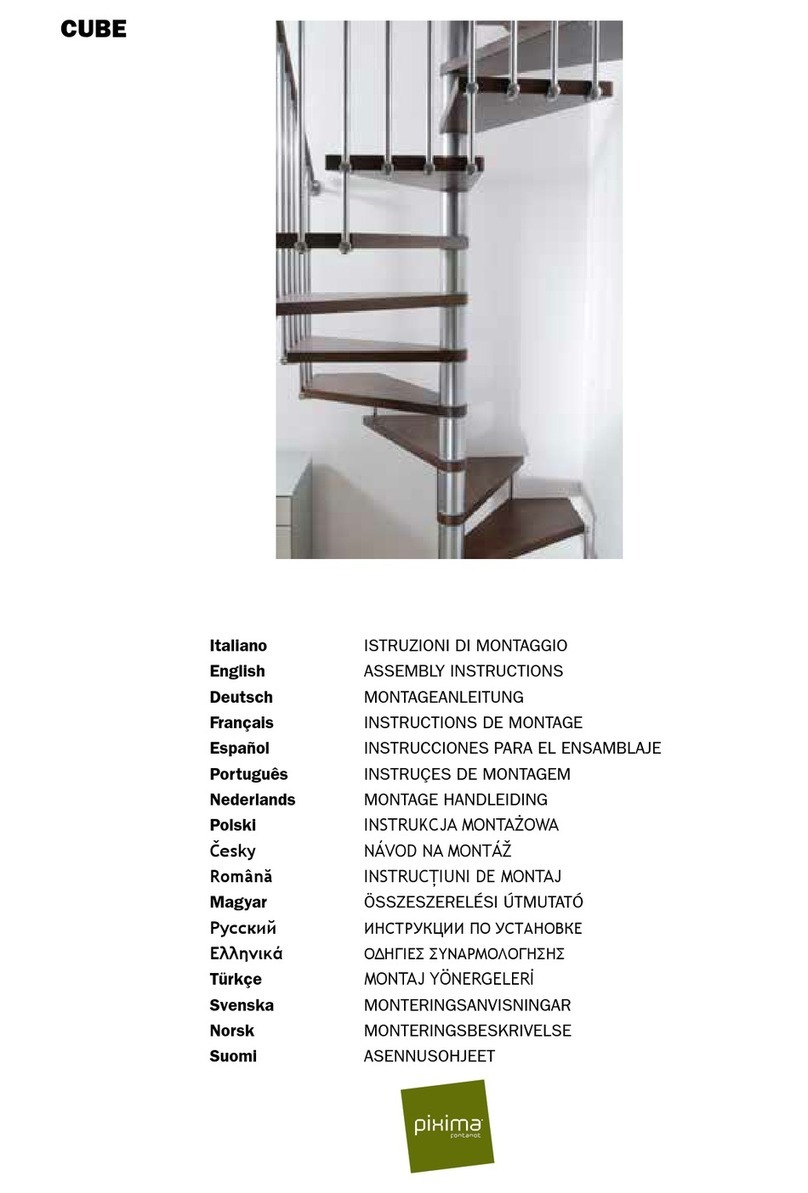
Fontanot
Fontanot pixima CUBE User manual

Fontanot
Fontanot Steel 30 User manual

Fontanot
Fontanot oak90.xtra User manual
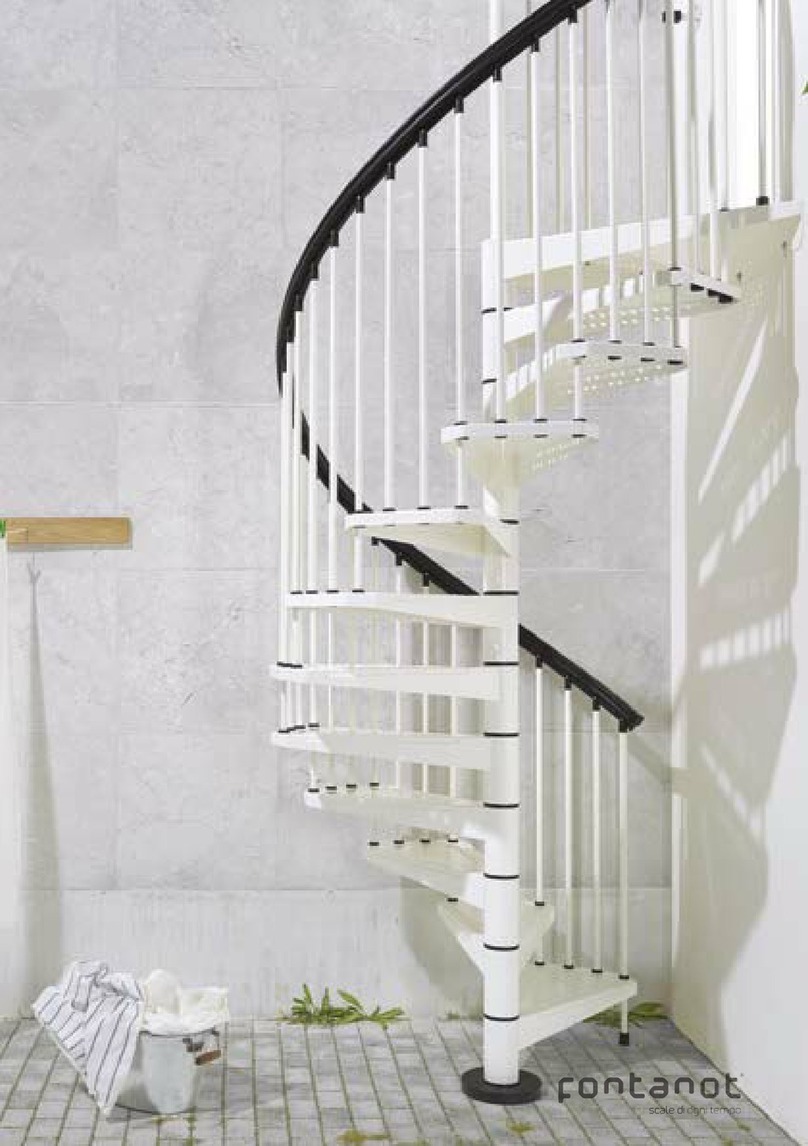
Fontanot
Fontanot SKY030 User manual
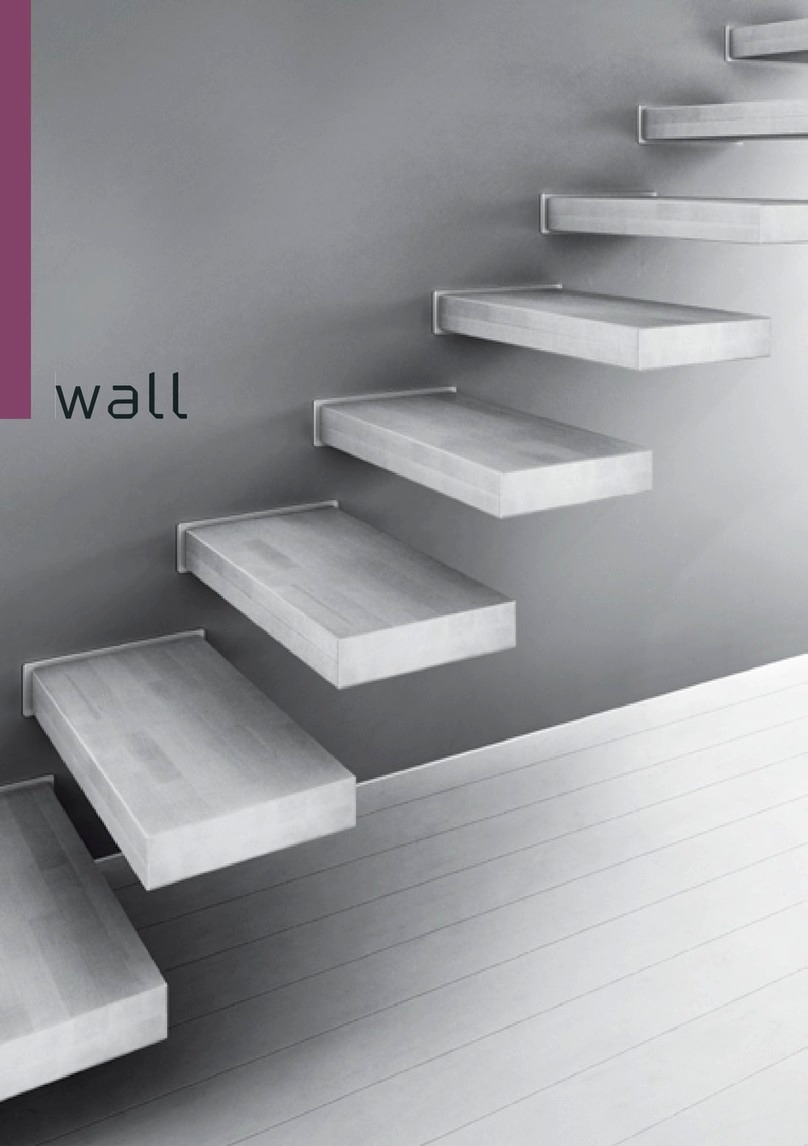
Fontanot
Fontanot wall User manual
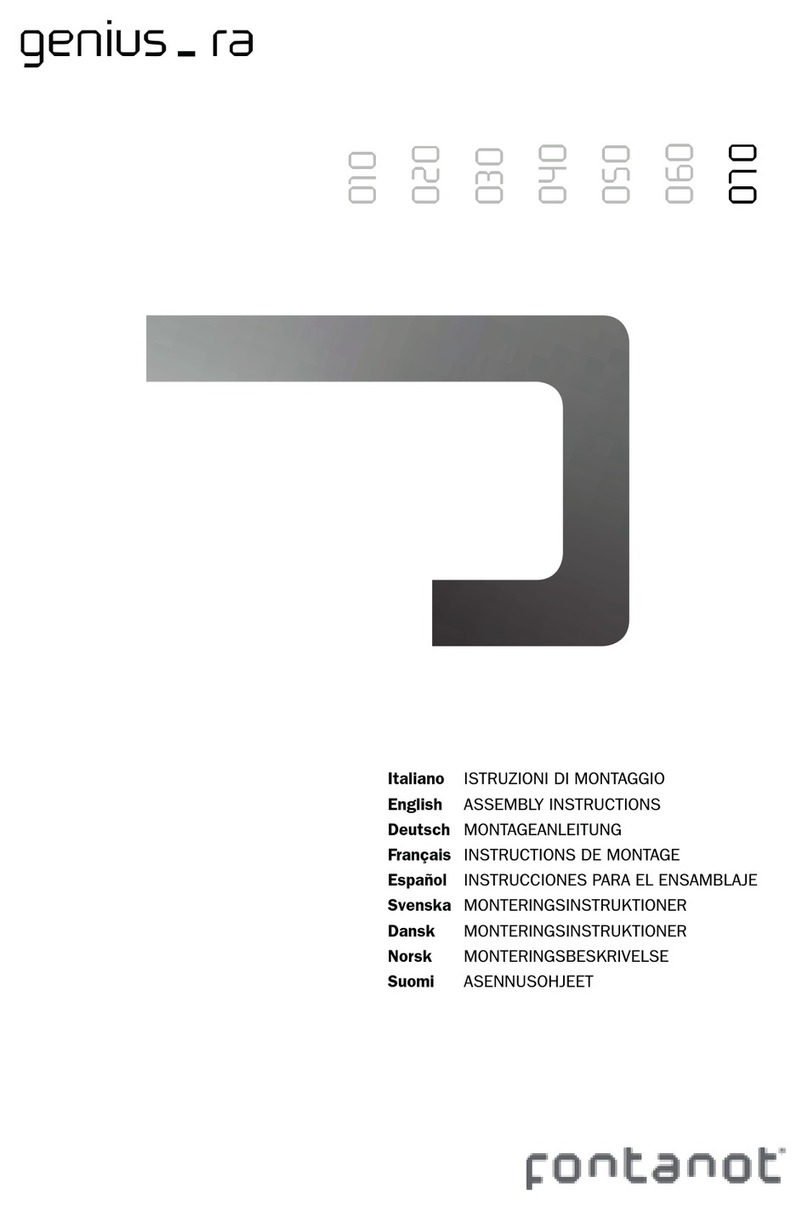
Fontanot
Fontanot genius_ra 070 User manual
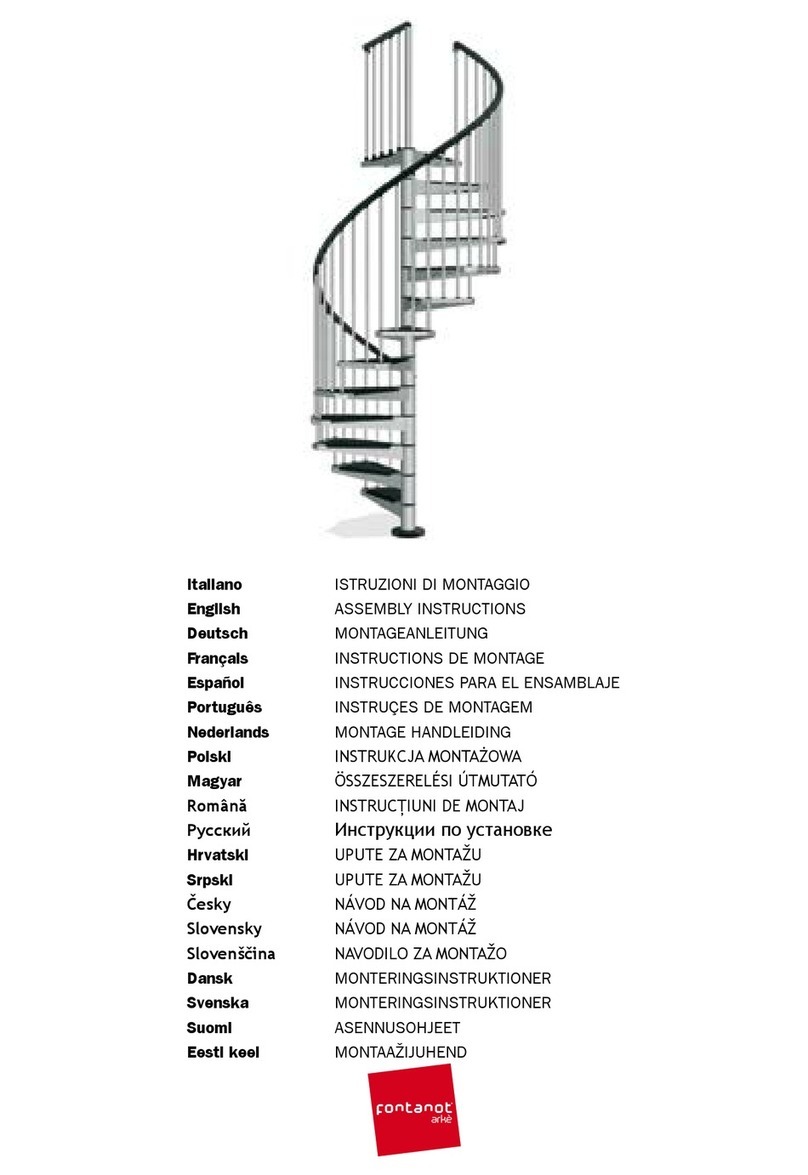
Fontanot
Fontanot Klio Series User manual
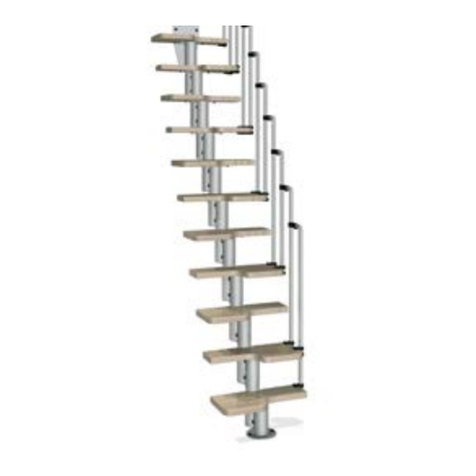
Fontanot
Fontanot ARKE KARINA User manual
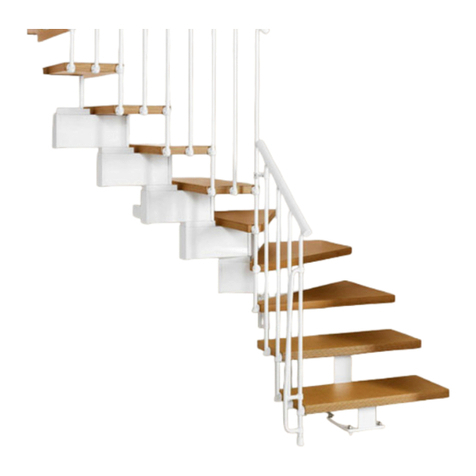
Fontanot
Fontanot Magia90 User manual
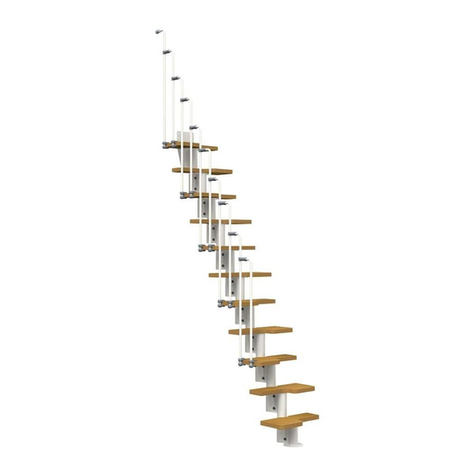
Fontanot
Fontanot nice 2 User manual
